Users Manual
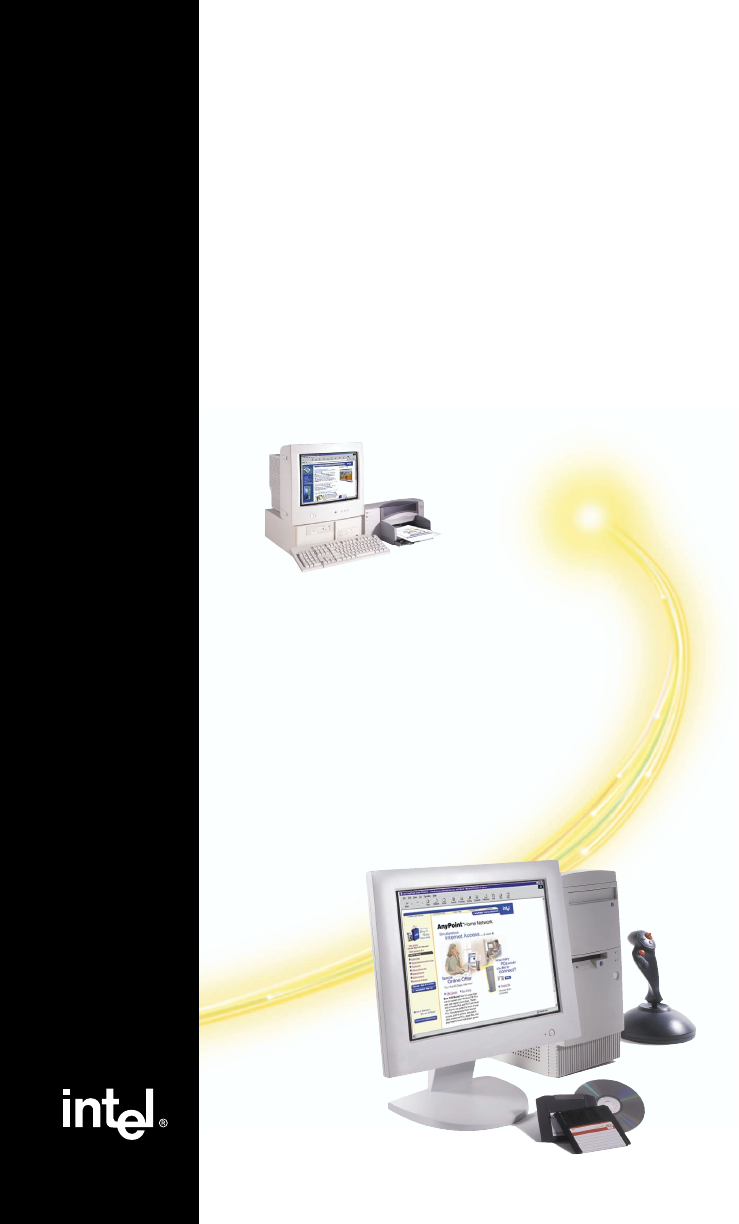
AnyPoint
Wireless II Network
User’s Guide
Share
internet
access
printers, files,
games,
and more…
™

ii
Contents
1 Understanding your
AnyPoint™ Wireless II Network..................................... 1
What is a network?............................................................................................................. 2
Components required to connect a PC to a network.......................................................... 2
Your Wireless II network adapter.............................................................................. 2
Device driver and wireless adapter settings............................................................... 2
The AnyPoint Connectivity Software Suite CD ........................................................ 3
How does my Wireless II adapter operate?........................................................................ 3
Peer-to-Peer mode...................................................................................................... 3
Infrastructure mode .................................................................................................... 4
How do I use my Wireless II laptop in different locations?............................................... 5
What is the AnyPoint Connection Manager?..................................................................... 6
What are Wireless II adapter and operating system settings?.................................... 6
What is a profile? ....................................................................................................... 7
What is network switching?....................................................................................... 7
What settings are switched in a network profile? ...................................................... 7
What is sharing and mapping? ........................................................................................... 8
What is Internet Sharing Software (ISS)?.......................................................................... 9
What is a Firewall?..................................................................................................... 9
What is Web site filtering?....................................................................................... 10
Guidelines for setting up your network............................................................................ 10
2 Set Up the
AnyPoint™ Wireless II Network................................... 11
Where do I begin? ............................................................................................................ 11
Install the AnyPoint software........................................................................................... 11
Share drives and printers.................................................................................................. 15
Configure the Internet Sharing Software (ISS) server ..................................................... 18
Configure the ISS connection .................................................................................. 19
Set up the Firewall ................................................................................................... 20
Set up Parental Control ............................................................................................ 23
Set up AnyPoint Connectivity Suite Extras ............................................................. 26
Registration ...................................................................................................................... 26

iii
3 Share Drives and Printers .......................................... 27
Use network drives........................................................................................................... 27
Use files across the network............................................................................................. 28
Viewing video files across the network ........................................................................... 28
Change drive sharing and mapping.................................................................................. 29
Change drive access ................................................................................................. 29
Change drive mapping ............................................................................................. 30
Change printer sharing and mapping ............................................................................... 30
Change printer sharing ............................................................................................. 30
Change printer mapping........................................................................................... 30
Install printer drivers................................................................................................ 31
Unmap a printer........................................................................................................ 31
Share and map automatically ................................................................................... 32
Multiple user profiles ....................................................................................................... 32
4 Connect to the Internet ............................................. 33
Connect to the Internet using ISS..................................................................................... 33
Connect from the ISS server .................................................................................... 33
Connect from an ISS client ...................................................................................... 34
Exiting or bypassing ISS when connecting to the Internet .............................................. 35
View connection status and settings................................................................................. 36
Change the ISS server ...................................................................................................... 36
Connecting with Virtual Private Network (VPN)............................................................ 37
5 Managing your Wireless II
Network .................................................................... 38
Using the AnyPoint Connection Manager ....................................................................... 38
Wireless Control Panel tab....................................................................................... 38
Profile Manager tab.................................................................................................. 38
View and edit current settings using the Wireless Control Panel tab .............................. 39
Activate a profile.............................................................................................................. 40
Creating a new profile...................................................................................................... 41
What are the profile configuration types?................................................................ 41
What are the profile modes? .................................................................................... 41
Scan for public access points ........................................................................................... 42
Create a profile for a public access point......................................................................... 43
Create an AnyPoint profile for your home or small office .............................................. 46
Create a profile for a corporate wired network ................................................................ 50

iv
6 Troubleshooting ......................................................... 51
I can’t see a network PC from another PC....................................................................... 51
I have an insufficient permissions error when running Windows 2000........................... 52
Remove incompatible network adapters .......................................................................... 53
I can’t connect to my ISP from an ISS client PC............................................................. 54
I keep getting disconnected from the Internet without hanging up.................................. 55
Can I use Internet sharing software from more than one manufacturer?......................... 55
ISS and ICS (Internet Connection Sharing)..................................................................... 56
Network game problems .................................................................................................. 57
I can’t see a drive or printer on a network PC.................................................................. 58
I can’t map or print to a printer........................................................................................ 58
I can’t map to a drive........................................................................................................ 59
I can’t write or save files to a drive on a network PC...................................................... 59
Printer drivers not found .................................................................................................. 59
My laptop has speaker noise ............................................................................................ 60
I am trying to access my Wireless II network with an Intel PRO/Wireless adapter........ 60
I am trying to install a Wireless II adapter into an Intel PRO/Wireless network............. 61
My Wireless II connection keeps getting interrupted ...................................................... 62
What do the lights on my Wireless II adapter mean? ...................................................... 62
7 Internet Service Provider
Reference.................................................................. 63
Set up the network to share Internet access.............................................................. 63
Set up America Online* (AOL*) with ISS .............................................................. 63
Set up AT&T WorldNet* with ISS.......................................................................... 64
Set up CompuServe* 2000 with ISS........................................................................ 65
Set up continuous Internet connections with ISS..................................................... 66
8 Technical Support Option .......................................... 67
E-mail and Web Support.................................................................................................. 67
Phone Support .................................................................................................................. 67
Agency Notices ......................................................... 68
Glossary .................................................................... 70
Specifications ............................................................ 73
Index ......................................................................... 76
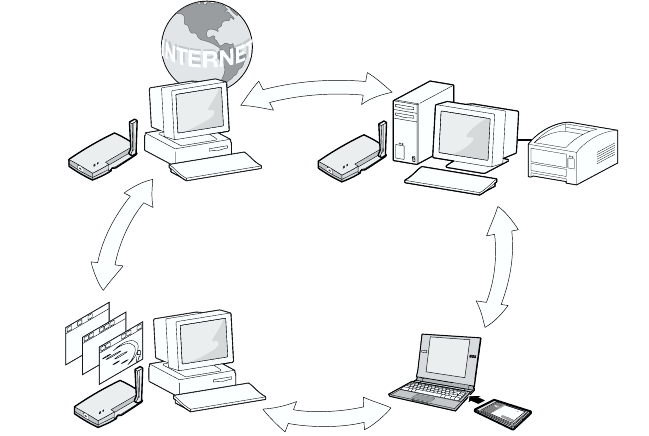
1
Understanding your
. . . . . . . . . . . . . . . . . . . . . . . . . . . . . . . . . .
AnyPoint™ Wireless II Network
1
This chapter provides a basic understanding of network principles, so you
can begin to take advantage of your new AnyPoint™ Wireless II Network.
It also gives you useful information that will help you modify your network
to meet your changing needs.
To get the most out of your home or small business network, think about
what you can gain when you connect all your PCs together so they work as
a group. For example, with two or more PCs connected together, you can:
•Share an Internet connection
•Share a printer
•Share files such as spreadsheets and written documents
•Play digital audio from another PC
•Play head-to-head multi-player games
•Use your laptop at home and at work
And the included Firewall and Web site filtering features help you to:
•Protect your network from electronic intrusion
•Block access to objectionable Web sites
A network allows multiple users to share resources.
AnyPoint
Wireless Home
Network

CHAPTER 1 Understanding your AnyPoint™ Wireless II Network
2
What is a network?
A computer network consists of two or more PCs that are able to
communicate with each other. Through a network, multiple PCs can share
resources, such as printers, an Internet connection, or stored data. It costs
less to share resources than provide every PC with its own printer or
Internet connection.
You can also access a file located on other PCs in the network just as if the
file was located on your own PC. For instance, from a PC upstairs, you may
want to listen to a large music file or view digital photos located on another
PC downstairs. You can keep the files for large applications on a system
with a larger drive capacity and then access those files with other PCs in the
network.
Components required to connect a PC to a network
To make your AnyPoint™ Wireless II network function, you need three
components.
1A Wireless II network adapter for each PC
2A device driver and wireless settings
3An AnyPoint™ Connectivity Suite CD
Your Wireless II network adapter
A network adapter is a hardware device that provides the connection
between your PC and the network. The adapter converts the data inside
your PC to a form that can be sent to other PCs. It connects externally to
your PC through the Universal Serial Bus (USB), or in the case of a laptop
PC, through a PC card.
Wireless adapters use radio waves as the means of connection, and transmit
data through the air just like a cordless telephone; no connecting wires
between PCs are necessary. The wireless adapter can communicate with all
PCs in the network as long as they are in close proximity to each other (up
to 300 feet). Keeping the adapters physically close to one another will
improve the speed of data transmission.
Device driver and wireless adapter settings
Your Wireless II adapter requires a device driver to function. The driver is
actually software code that specifically controls how the PC and the adapter
communicate with each other. The wireless adapter settings control how
your Wireless II adapter communicates with the other adapters in the
network. You cannot change the device driver software, but as you will
learn later in this chapter, you can change the adapter settings.

Understanding your AnyPoint™ Wireless II Network CHAPTER 1
3
The device driver and adapter settings are installed when you first set up
your AnyPoint™ Wireless II Network using the Installation Guide.
The AnyPoint Connectivity Software Suite CD
The AnyPoint Connectivity Software Suite is on your CD. It contains
programs for your home and small business network. During network
installation, you install this software:
•Device driver for your network adapter
•AnyPoint Sharing and Mapping software
•AnyPoint Internet Sharing software (ISS)
•Firewall for Internet security
•Web site filtering for Parental Control
•The AnyPoint Connection Manager to manage your Wireless II
network
•Anypoint Extras for additional entertainment applications
For instructions to install the AnyPoint Connectivity Software Suite, see
"Install the AnyPoint software" on page 11.
How does my Wireless II adapter operate?
The network mode is one of the adapter settings you must enter during
installation. Wireless networks can operate in one of two modes:
1 Peer-to-Peer (sometimes called Ad Hoc)
2 Infrastructure
Peer-to-Peer mode
In the peer-to-peer mode, sometimes called ad-hoc mode, PCs transmit and
receive data directly with other PCs in the network using radio waves.
Coordination of data traffic between PCs is done automatically. The
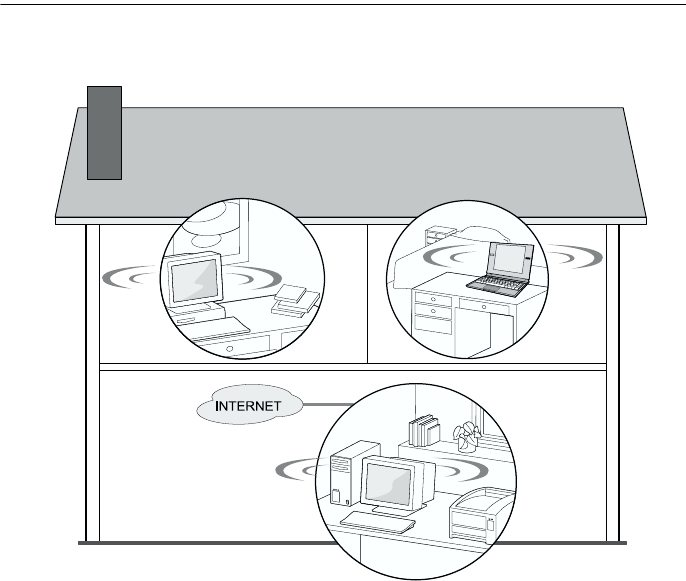
CHAPTER 1 Understanding your AnyPoint™ Wireless II Network
4
following figure shows PCs with Wireless II adapters in various rooms of a
house communicating directly with one another in peer-to-peer mode.
Infrastructure mode
In the Infrastructure mode, PCs transmit and receive data to and from a
gateway or an access point (AP). Many corporate networks use access
points, which serve as a communications hub for all PCs using 802.11b
wireless adapters to connect to a wireless or wired LAN. A residential
gateway can be used in home networks to connect to the Internet.
The following figures show examples of two types of Infrastructure
networks. The first illustration shows a wireless PC and a public access
point in an airport. These access points are sometimes called hotspots. The
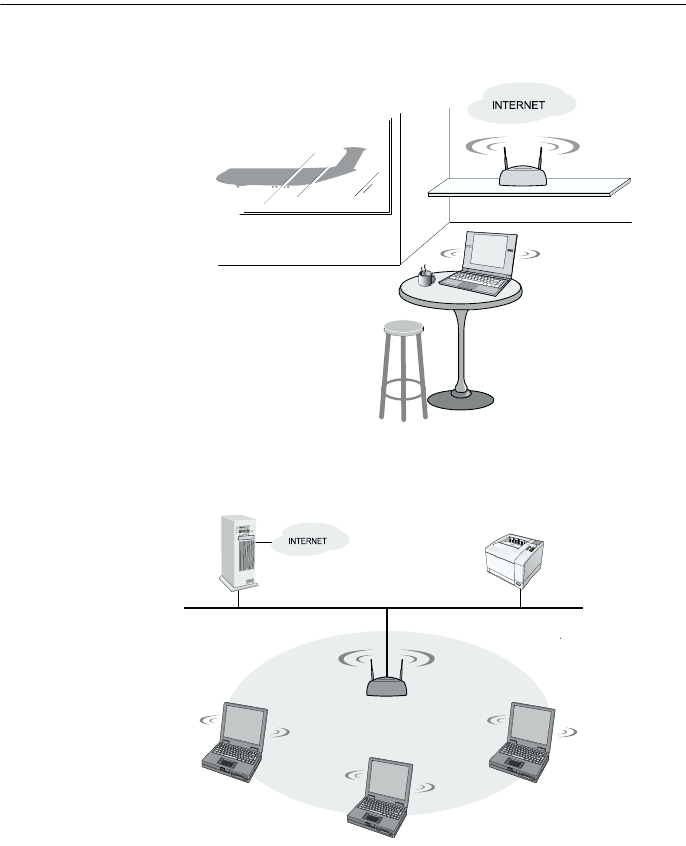
Understanding your AnyPoint™ Wireless II Network CHAPTER 1
5
laptop with a PC card adapter is accessing the Internet by transmitting and
receiving data from the access point.
The second illustration shows how wireless PCs connect to a corporate
network through an access point. Laptops with wireless adapters can access
the resources on the wired network including the Internet and servers.
How do I use my Wireless II laptop in different
locations?
You can connect your laptop to potentially any network with 802.11b
technology. In your home, you can carry your laptop from room to room
and stay connected. You can take your laptop to your office, change a few
wireless adapter settings, and connect to your office network. And while at
Wired Network

CHAPTER 1 Understanding your AnyPoint™ Wireless II Network
6
work, you can travel between your office, a conference room, and an
outdoor courtyard and remain connected to the work network and its
resources.
To easily connect to other networks, you can use the AnyPoint Connection
Manager software.
What is the AnyPoint Connection Manager?
The AnyPoint Connection Manager is a software tool that is available when
you install your AnyPoint Wireless II adapter. The basic job of the
AnyPoint Connection Manager is twofold:
•Edits Wireless settings - You can quickly edit your current Wireless II
settings of your adapter.
•Creates Profiles - You can save the Wireless II adapter and operating
system settings into a single network profile. The software lets you
create as many profiles as you wish, and switch between them at any
time.
Before you can perform these tasks, you need to understand three concepts:
1Wireless II adapter and operating system settings
2Profiles
3Network switching
What are Wireless II adapter and operating system
settings?
The wireless II adapter settings are wireless controls that the adapter
needs to communicate with the network. Within the standard 802.11b
technology, there are several settings as defined by Institute of Electrical
and Electronics Engineers (IEEE). To use your Wireless II laptop in
multiple networks, you need to change a few of these settings using the
AnyPoint Connection Manager Profile Manager tab (see "Profile Manager
tab" on page 38). The major settings include:
•Network ID Code (SSID) - This is the network identification code. All
devices that you are connecting to must have the same SSID to
communicate with each other.
•Mode - There are two operating transmission modes: Peer-to-Peer, or
Infrastructure. See page 3 in this chapter for more details.
•Encryption password- This is a security feature. The encryption
password is a unique feature of the AnyPoint software. Every AnyPoint
Wireless II adapter in the network must have the same encryption
password, which the AnyPoint software uses to automatically generate
the required 802.11b encryption keys.

Understanding your AnyPoint™ Wireless II Network CHAPTER 1
7
•Other settings - In some networks, you will be prompted to provide
other 802.11b settings.
The operating system settings define shared and mapped drives, printers,
browsers, TCP/IP (addressing) functions and standard windows operating
settings. You can also save these settings in network profiles using the
Profile Manager tab.
What is a profile?
Network profiles contain all the setting listed in the previous section. For
example, you can set up several network profiles — one for your AnyPoint
home network; another for your place of business, and yet another for
public access points. The AnyPoint Connection Manager software lets you
setup as many profiles as you need.
What is network switching?
The AnyPoint Connection Manager lets you easily witch between multiple
networks. When shutting down or starting your PC, you can select which
network profile to use. For more details, see "Using the AnyPoint
Connection Manager" on page 38.
What settings are switched in a network profile?
Each network profile contains the settings found in the Network Control
Panel, as well as a few others.
Wireless settings:
•All 802.11b settings including network ID code, mode, channel, and
encryption
Operating system settings:
•Microsoft Internet Explorer* (4.0 and later) proxy settings
•Network resource settings, such as file and printer sharing settings,
default printers, mapped drives (Windows 95 and Windows 98 only),
and shared folders
•Some TCP/IP settings (found on the network control panel’s TCP/IP
properties tab)
•Windows domain settings
•User name and Host name
•Software running at startup for the AnyPoint applications
Note: You rarely change profiles on your desktop PC, unless you
are adding an access point or gateway into your network. For a
laptop PC, you may add several profiles for use in several
networks.
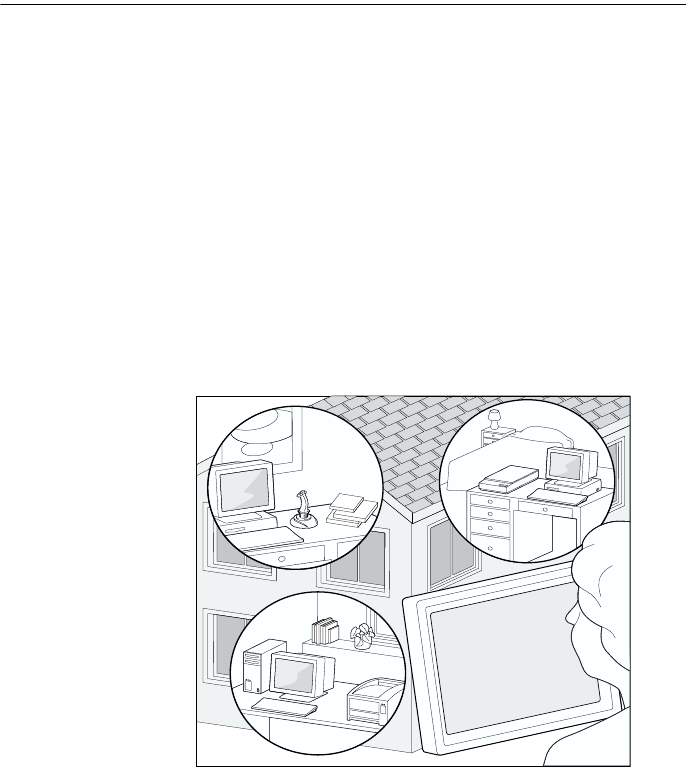
CHAPTER 1 Understanding your AnyPoint™ Wireless II Network
8
What is sharing and mapping?
The concept of sharing and mapping is actually a two-fold process that
allows two or more PCs to locate and use each other’s drives and printers as
if they were on one single PC. The two processes work together. The
AnyPoint Sharing and Mapping software allows you to first decide which
drives and printers on each PC are to be shared with the network. Then, the
software allows you to map to each shared drive and printer from each PC.
The sharing process lets you control the degree of access by setting the
share status for each of your drives and printers. For drives, you would
select either Shared-Full, Shared-Read Only or Not Shared. For printers,
you would select either Shared or Not Shared. Refer to "Share drives and
printers" on page 15 for a description of each type of share status. The
mapping process sets up a drive letter on your PC that points to each shared
drive on the other PC. You can even assign your own letters to a drive (if
they are not already used by the system).
D:
F:
D: Home Office
E: Joe's Room
F: Jane's Room
Printer
E:
Printer

Understanding your AnyPoint™ Wireless II Network CHAPTER 1
9
What is Internet Sharing Software (ISS)?
AnyPoint Internet Sharing Software (ISS) allows all of your PCs to share
one PC’s Internet connection. With AnyPoint Wireless II adapters, ISS is
available only in Peer-to Peer mode, when all PCs communicate directly
with each other. You merely set up the PC with the Internet connection as
an ISS server. You then set up the remaining PCs as ISS clients. The ISS
server PC directs data between the Internet and all PCs on the network.
Because each client PC connects to the Internet through the server, only the
server PC needs the actual physical connection to the Internet (see
"Connect to the Internet" on page 33). With the server on, any other PC in
the network has access to the Internet. Also, for connecting to virtual
private networks with Internet access, see "Connecting with Virtual Private
Network (VPN)" on page 37.
The ISS server also provides Internet security with Firewall and Web site
filtering.
What is a Firewall?
A Firewall helps prevent intruders (hackers) from breaking into your home
or office network. When your connection to the Internet is active, the
Firewall acts like a barrier to outside intrusion.
Note: If you are connecting to a network such as an access point
or a gateway, you cannot use ISS, the Firewall, and Web site
filtering. Refer to the documentation for the access point or
gateway for setting up connections to the Internet.

CHAPTER 1 Understanding your AnyPoint™ Wireless II Network
10
Once you install the Firewall through your ISS server, it works silently to
protect your PC whenever the ISS server PC is operating.
The Firewall has four security levels: Trusting, Cautious, Nervous and
Paranoid. Inbound traffic is blocked according to the security level you
select. The more restrictive the security level, the more likely the Firewall
will block unsolicited inbound traffic. Paranoid is the most restrictive and
Trusting is the least restrictive. Refer to the section "Set up the Firewall" on
page 20 for more information.
What is Web site filtering?
The AnyPoint Connectivity Software Suite identifies and filters Web page
content in specified categories (such as pornography, hate speech, weapons,
drugs, and gambling). At home, you can set up Parental Control to block
undesirable Web pages from appearing on specific PCs on your network.
Refer to the section "Set up Parental Control" on page 23 to set up each PC
with different levels of Web access:
•Select the option Automatically filter Web sites to automatically filter
objectionable sites. You can add exceptions to the automatic option for
sites you wish to allow or filter.
•Select Allow these sites only to specify an acceptable list of Web sites
each PC can visit. You must click Configure and type the specific
HTTP sites you want to allow.
•Select No restrictions to disable Parental Control.
Web site filtering does not block chat programs, download sites, e-mail, or
news groups.
Guidelines for setting up your network
It is easy to set up your network, but you need to plan a little. Draw a
diagram showing the location of PCs and printer(s). Indicate the location of
data or printers you want to be available to everyone on the network and
other data or printers you do not want to be available to everyone. It is
important to identify the PC you will use for your shared Internet
connection. This is usually the PC with the fastest connection through your
modem (or cable).
Important: A Firewall provides protection against unauthorized
access by hackers, but you will still need additional software to help
protect you against computer viruses.

11
Set Up the
. . . . . . . . . . . . . . . . . . . . . . . . . . . . . . . . . .
AnyPoint™ Wireless II Network
2
Where do I begin?
See "What is a
network?" on
page 2.
There are four steps to successfully installing and configuring your
AnyPoint™ Wireless II Network:
1Install the hardware and drivers and your 802.11b wireless settings.
Refer to the AnyPoint Wireless II Network Installation Guide (the
poster included with the adapter) for detailed, step-by-step instructions.
2Install the AnyPoint Connectivity Software Suite.
See "What is
sharing and
mapping?" on
page 8.
3Share drives and printers.
"Share drives and printers" on page 15 explains how to share your
network drives and printers for the first time.
See "What is
Internet Sharing
Software (ISS)?"
on page 9.
4Set up the Internet Sharing Software (ISS) server.
ISS also enables the Firewall and Parental Control features on the
AnyPoint Wireless II Network. See "Configure the Internet Sharing
Software (ISS) server" on page 18.
Install the AnyPoint software
Once you’ve installed the hardware and drivers using the Installation
Guide, you are ready to install the software using the setup program and the
instructions from this chapter. The setup program guides you through the
Important: If you already have BlackIce Defender* installed on your
system, you may want to choose between AnyPoint or BlackICE
Firewalls before installing your software. To help you decide, review
the table in the section"Set up the Firewall" on page 20.
Important: If you are upgrading your operating system, uninstall
your AnyPoint™ software first, perform the upgrade, then install the
AnyPoint Software.
Important: (Windows* 2000 users) You will receive a screen
notifying you not to install the AnyPoint Wireless II Network unless
you log in to an account that has administrative rights.
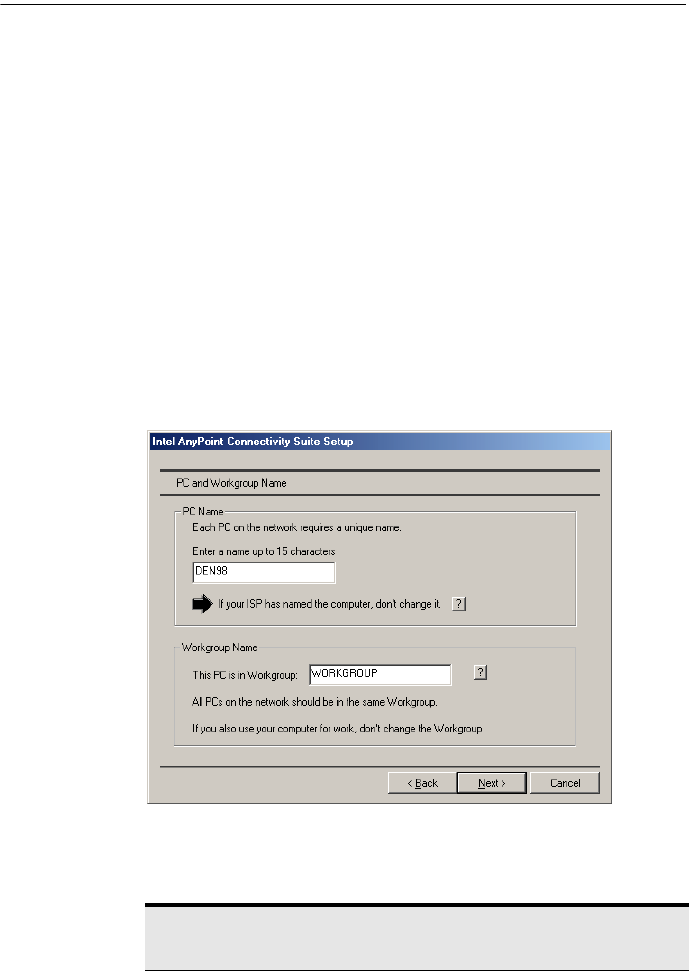
CHAPTER 2 Set Up the AnyPoint™ Wireless II Network
12
installation process. During installation, you will be making decisions that
will affect the way your network operates, so be sure to pay careful
attention to the screens.
1Insert the AnyPoint Connectivity Suite CD in the CD-ROM drive.
Using Windows Explorer, double-click the CD-ROM drive, then
double-click Setup to begin. The main presentation screen appears.
2Click Install. An installation summary screen appears. Click Next. The
license agreement screen appears.
See "Your
Wireless II
network adapter"
on page 2.
If Setup detects an incompatible network adapter already installed on
your PC, the More than one network adapter found screen appears. If
you receive this screen, refer to "Remove incompatible network
adapters" on page 53, which will show you how to resolve the adapter
conflict. If you do not receive this screen, go to the next step.
3Click I Accept or I decline the agreement. If you decline, the Setup
program exits. If you click Accept, the destination directory appears.
4Click Next to select the default directory. The PC name screen appears.
5Assign a name to the PC. Be sure to use a different name for each PC
on the network. Make a note of the Workgroup name. All PCs must use
the same Workgroup name.
The PC name
can have up to
15 characters,
including any
combination of
letters (A-Z),
numerals (0-9),
and dashes (-).
Important: If your ISP has named the PC, don’t change the PC’s
name.
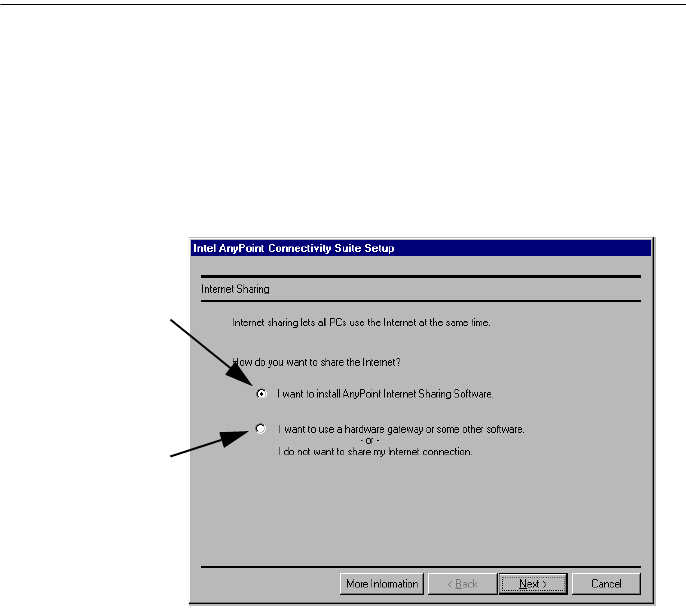
Set Up the AnyPoint™ Wireless II Network CHAPTER 2
13
6When the summary screen appears, review your network configuration
choices carefully before you click Install. Once you install, you cannot
come back to this screen without reinstalling the software.
7You will be notified that your software installed successfully. Click OK.
The following screen helps you decide if you want to install the
AnyPoint Internet Sharing Software (ISS) for use with an Internet
Service Provider (ISP).
8Select one of the following options:
•I want to install AnyPoint Internet Sharing Software. Choose this
default option if you want to use the AnyPoint Internet Sharing
Software (ISS) to share Internet access with all PCs in your home
network. For more information on ISS, refer to "Connect to the
Internet using ISS" on page 33. If you choose this option, go to step 9.
•I do not want to share my Internet connection. Choose this option if
you use other software for Internet sharing, a Virtual Private Network
(VPN), a gateway or access point, or do not want AnyPoint™ Internet
Sharing Service (you can always install it later). For installing to
VPN, refer also to "Connecting with Virtual Private Network (VPN)"
on page 37.
After you select one of the above options, click Next.
If you do not install the Internet Sharing Software, the install program
will skip the remaining ISS screens.
If you use other
software for Internet
sharing or you have
chosen not to have
Internet Sharing
Service, then click
here. Also, if you plan
to install a gateway,
an access point
device, or a Virtual
Private Network, do
not install Internet
Sharing Software.
Click here if you want
to install ISS on your
server PC.
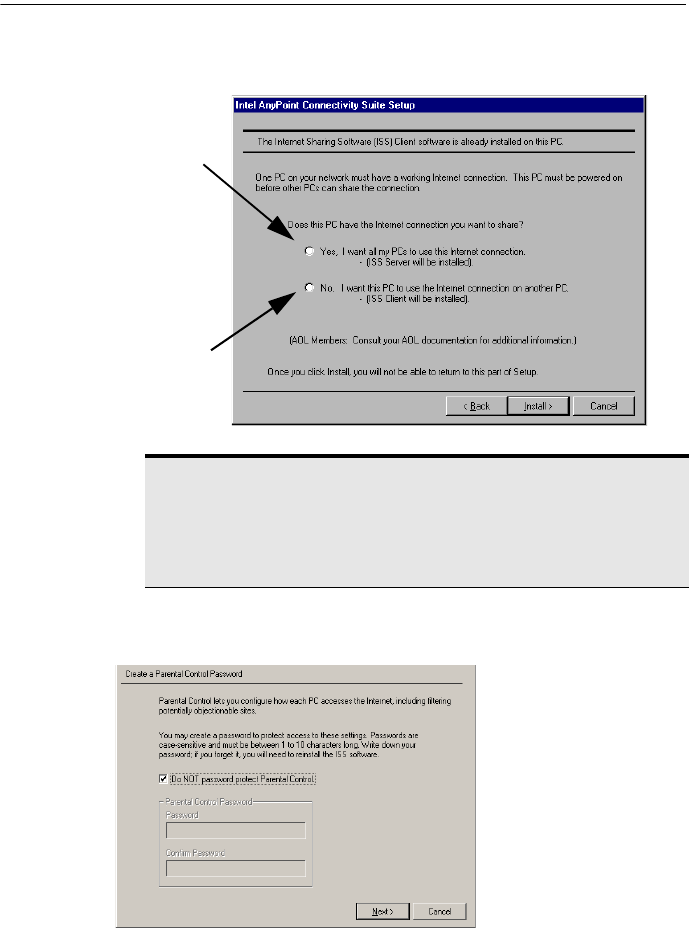
CHAPTER 2 Set Up the AnyPoint™ Wireless II Network
14
9A decision screen appears. Decide whether this PC is going to be the
ISS server or an ISS client, then click Install.
10 If this PC is the ISS server, type in a Parental Control password for Web
site filtering. If you don’t want a password, just click Next.
The password can be from 1-10 characters and is case-sensitive.
Therefore, PASSWORD, Password, and password would each be
considered unique. If you choose to create a password, no one can
make changes to the Parental Control settings unless they enter the
password when prompted.
Note: For most Internet Service Providers (ISPs), the Internet
connection is shared automatically when you install ISS. However,
some ISPs may require extra steps to work with ISS. Cable
modems and DSL may also require special steps (see "Internet
Service Provider Reference" on page 63 for more information).
ISS Server
The network can have only
one ISS server and it must be
set up and running (not
turned off) to share its
Internet connection with ISS
clients.
ISS Client
ISS clients can access the
Internet through the ISS
server PC.
Be sure to write
down the password
you enter. If you forget
the password later,
you will have to
uninstall and then
reinstall the AnyPoint
Connectivity Software
Suite to make any
changes to the
Parental Control
settings.
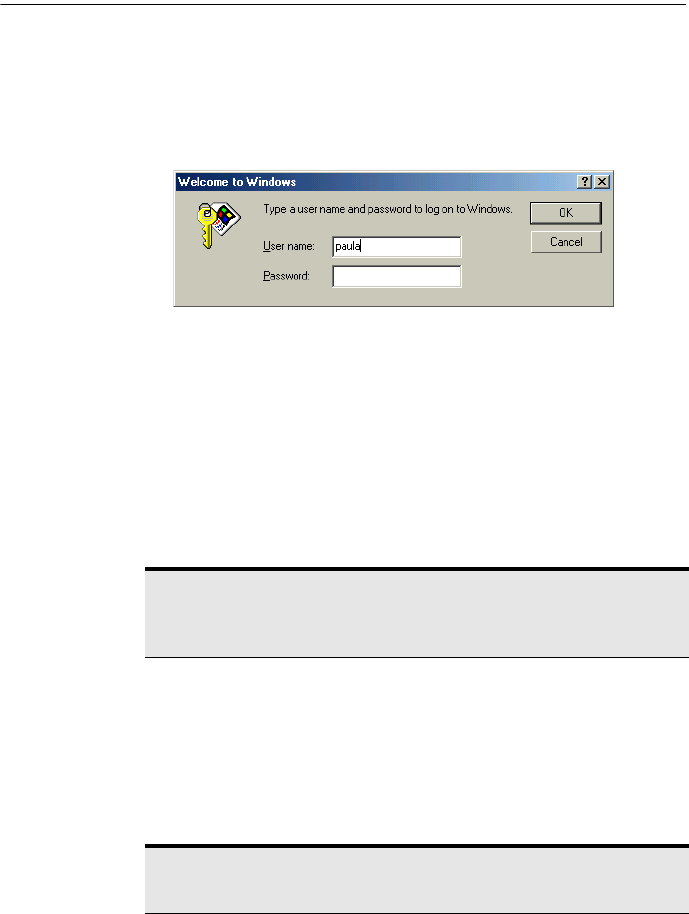
Set Up the AnyPoint™ Wireless II Network CHAPTER 2
15
11 Click Next then Finish. A confirmation screen appears notifying you
that your software has successfully installed. You will then be
prompted to restart the PC.
12 When your PC restarts, you are prompted to type a user name to log on
to the network.
Share drives and printers
See "What is
sharing and
mapping?" on
page 8.
The Sharing and Mapping Software lets you locate and use drives and
printers from several PCs as if they were on one single PC. The first time
you run the Setup program, the Sharing and Mapping Software runs
automatically (skip to step 2 below).
To share a drive:
1Click Start > Programs > Intel AnyPoint Network > Sharing and
Mapping Software
The Windows user name can be
different from the PC name you
typed when you installed the
AnyPoint Wireless II Network
software. You do not need to
have different user names at
each PC, but you can if you
wish.
Windows passwords are associated
with user names. If you don’t create a
password now, you are not prompted
to type your user name each time you
restart this PC. If you create a
password, you must type the same
password each time you log on to this
PC with this user name.
Important: Do
not click Cancel!
If you do, this PC
will not connect to
the network.
Note: At this point, your system includes a default network profile.
To view or edit those values, see "View and edit current settings
using the Wireless Control Panel tab" on page 39.
Important: Windows 2000 users should see "I have an insufficient
permissions error when running Windows 2000" on page 52.
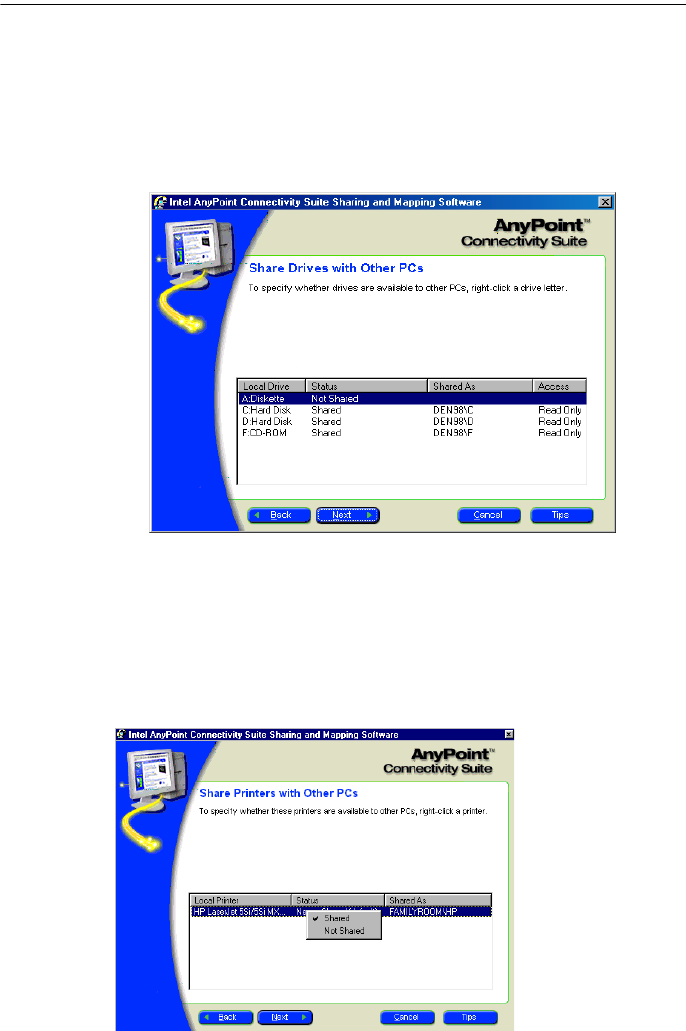
CHAPTER 2 Set Up the AnyPoint™ Wireless II Network
16
A decision screen asks if you want to set up your PC to share drives and
printers. Click Yes. An informational screen describing Sharing and
Mapping appears. Click Next to continue.
2In the Share Drives With Other PCs screen, right-click on any drive to
change the share status, selecting options from the menu. By default, all
drives, except floppy disk drives, are set up as Shared - Read Only.
3Click Next. The Share Printers with Other PCs screen appears.
If you don’t want others to use the drive, select Not Shared.
If you want others to see or copy the files and folders from the
shared drive, but not change, save, or delete them on the
shared drive, select Shared - Read Only.
If you want others to view, copy, change, save, or delete the
files and folders on the shared drive, select Shared - Full.
Printers are shared
by default. If you
don’t want to share
a printer, right-click
the printer in the list
and select Not
Shared.
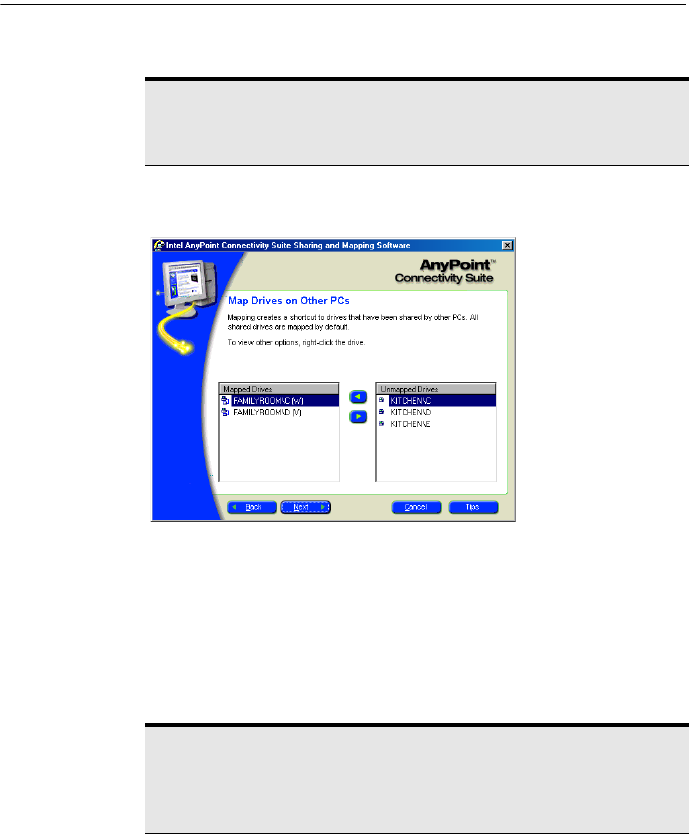
Set Up the AnyPoint™ Wireless II Network CHAPTER 2
17
4Click Next. The Map Drives on Other PCs screen appears.
Note: The following screen does not appear if the drives on other
networked PCs have not been shared (for example, if this is the first
PC on the network), or if the other PCs are turned off.
Note: When you map to a drive, an icon for that PC is
automatically placed on your Windows desktop. You can quickly
access a mapped drive by double-clicking the desktop icon. For
Windows 95 users, you will need to create the shortcut manually.
To unmap a drive, select the drive from the Mapped
Drives box then click the right arrow to move it to the
Unmapped Drives box.
To change a mapped drive letter, right-click the drive,
point to Properties, select another available letter from
the Drive box, and click OK.
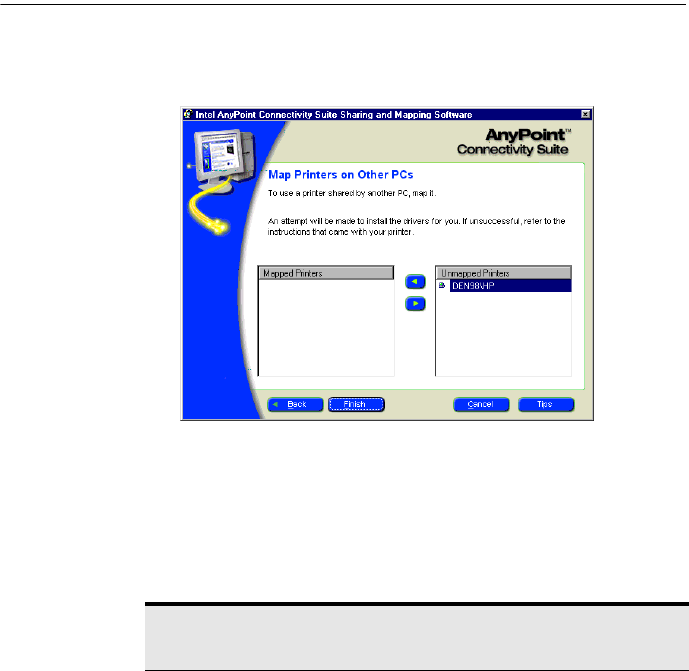
CHAPTER 2 Set Up the AnyPoint™ Wireless II Network
18
5Click Next. The Map Printers on Other PCs screen appears. To use a
shared printer, you need to map it. Printers are not mapped by default.
To map another printer, repeat step 5.
6Click Finish after mapping to your printers and drives.
Your printers and drive shares are set up for Sharing and Mapping!
Configure the Internet Sharing Software (ISS) server
See "What is
Internet Sharing
Software (ISS)?"
on page 9.
Now that you have finished installing the software and configuring shared
drives and printers, you are ready to configure the ISS server. This includes
configuring the network’s:
•Connection settings
•Firewall
Note: The screen does not appear if other networked PCs haven’t
shared their printers, or if all other PCs are turned off.
•Select the printer in the Unmapped Printers box then click the left
arrow to move it to the Mapped Printers box.
•Windows should start the Add Printer Wizard. Make sure you
have the printer software disks that came from the printer
manufacturer or with the printer. To add the printer, follow the
instructions on the screen.
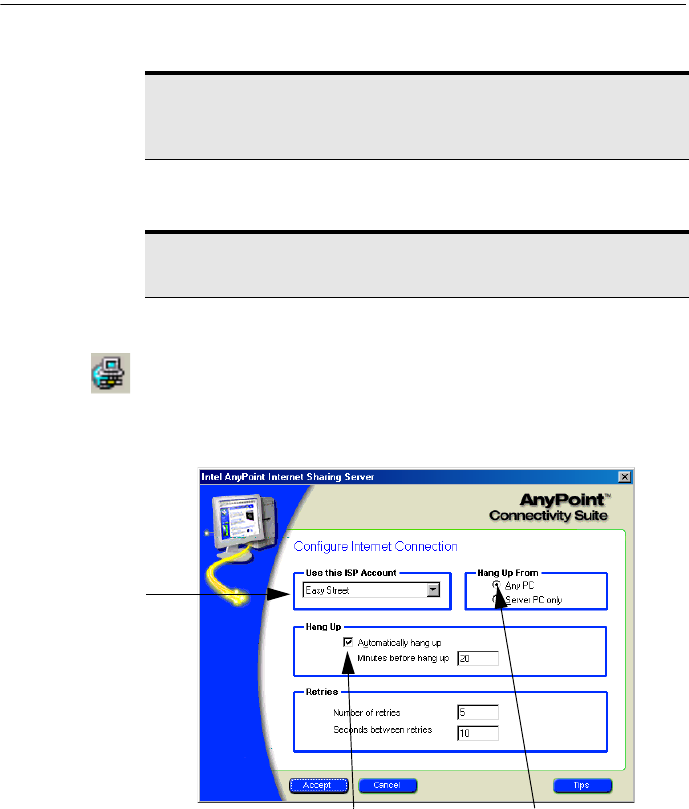
Set Up the AnyPoint™ Wireless II Network CHAPTER 2
19
•Parental Control for Web site filtering
Configure the ISS connection
To configure the ISS connection:
1At the ISS server PC, open ISS by double-clicking the ISS icon in the
taskbar.
2Click Configure. The Internet sharing server screen appears.
3Click Accept. The changes take effect the next time you connect to the
Internet through ISS.
Important: If you are using a gateway or access point in your
network, do not install ISS. Refer to the documentation for those
devices for instructions on connecting to the Internet.
Note: If you use a DSL service, cable modem, or other continuous
connection, the only setting you can change is the default ISP.
Type the number of minutes of
inactivity you want ISS to wait
before ending the Internet
connection. To disable automatic
hang up, uncheck Automatically
hang up.
To change the
default ISP, select
an account name
from the list.
Type the number
of times you want
ISS to redial
when the line is
busy and the
number of
seconds to wait
between redials. Select whether Any PC should
be able to hang up the
connection, or whether this
should be allowed from the ISS
Server PC only.

CHAPTER 2 Set Up the AnyPoint™ Wireless II Network
20
Set up the Firewall
See "What is a
Firewall?" on
page 9.
The AnyPoint Connectivity Software Suite includes a Firewall, which
helps protect your network from hackers trying to gain access. By default,
the Firewall is enabled when you install the ISS server software.
If you already have BlackICE Defender* by NetworkICE installed on your
system, you may want to choose between AnyPoint or BlackICE Firewalls.
For details, review the following table.
Important: If you use a third-party Firewall product other than
BlackICE Defender (such as Norton Internet Security* or McAfee),
reinstall the ISS portion of the AnyPoint software after installing the
firewall software. Use the instructions in "Install the AnyPoint
software" on page 11 (be sure to install as an ISS server). You may
need to make additional configuration changes to use the other
manufacturer’s Internet security software (see manufacturer’s
manual) with your AnyPoint Wireless II Network.
If you have BlackICE
installed If you do not have BlackICE
installed
and you want to use BlackICE:
1Uninstall BlackICE Defender
software using instructions
from the manufacturer.
2Disable the Anypoint Firewall
through the ISS software (see
page 22).
3Restart the PC.
4Reinstall BlackICE Defender.
and you want to use BlackICE:
1Disable the Anypoint Firewall
through the ISS software (see
page 22).
2Restart the PC.
3Install BlackICE Defender
software using instructions
from the manufacturer.
and you want the ISS Firewall:
1Uninstall BlackICE Defender
software using instructions
from the manufacturer.
2Restart the PC.
3Install the AnyPoint Internet
Sharing Software (ISS) on the
Server PC.
and you want the ISS Firewall:
Proceed with normal ISS
configuration instructions.

Set Up the AnyPoint™ Wireless II Network CHAPTER 2
21
Select a security level
The Firewall has four security levels: Paranoid (most restrictive),
Nervous, Cautious, and Trusting (least restrictive).
Change the security level
By default, the security level is set to Cautious, which prevents many
common Internet attacks while still letting you use most Internet programs.
To change the security level:
1Double-click the ISS icon to open ISS.
Security Level Description
Paranoid Blocks all inbound intrusions and restricts some
Web browsing and interactive content.
Nervous Restricts some interactive content on Web sites.
Does not affect streaming media and other
application-specific Internet usage.
Cautious (default) Blocks some inbound intrusions and does not
interfere with normal Internet usage. This setting
is best for regular use of the Internet.
Trusting Blocks file sharing over the Internet. Internet file
sharing allows the user to share files on their disk
with others across the Internet. Blocking Internet
file sharing ensures that hackers cannot
download files to your computer. Does not affect
file sharing on your AnyPoint network, even
though Internet file sharing is disabled.
Note: When you click on the ISS server icon and select the
Firewall tab, the Status and More Information buttons appear.
Status tells you if the Firewall is running. The More Information
button provides details about your Firewall.
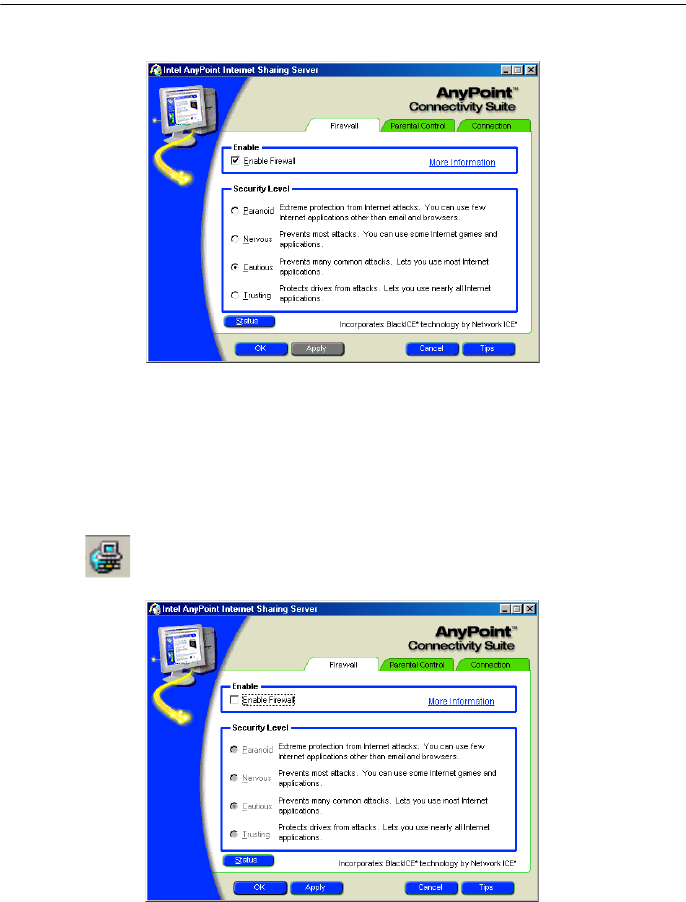
CHAPTER 2 Set Up the AnyPoint™ Wireless II Network
22
2Click the Firewall tab. The security level screen appears.
3Select the desired security level, then click Apply.
Disable the Firewall
If you do not want the protection of the Firewall (for example, if you have
another Firewall program), you can choose to turn it off.
To disable the Firewall:
1Double-click the ISS icon to open ISS.
2Click the Firewall tab.
3Click to clear the Enable Firewall check box, and click Apply.
4At the prompt to restart your PC, click Yes.
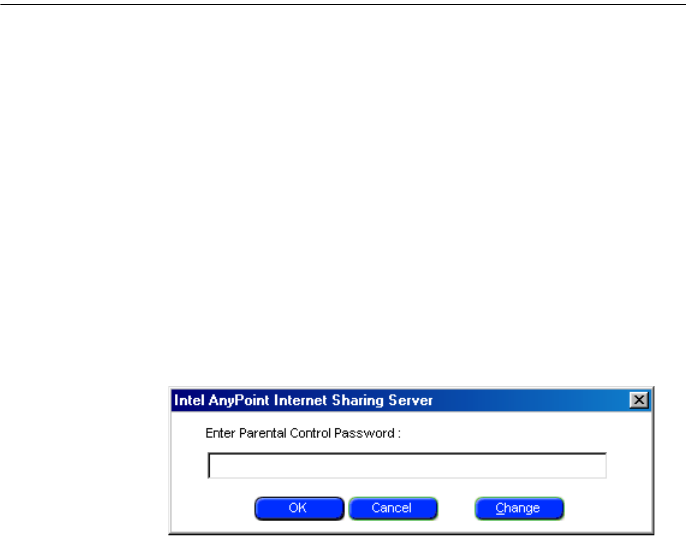
Set Up the AnyPoint™ Wireless II Network CHAPTER 2
23
Set up Parental Control
See "What is Web
site filtering?" on
page 10.
The Parental Control feature lets you filter the Web sites each PC can visit.
With Parental Control, you can assign different restrictions to each PC
running ISS. You can also specifically block or approve different sites. You
must use the ISS server to set up Web site filtering features. Also, client
PCs on the network must enter the Internet through the server for Parental
Control features to operate. If a client PC dials the Internet through a
separate modem, Parental Control features will not operate or protect the
client PC.
Setting up and changing the Parental Control password
To set up a password:
1Click Start > AnyPoint software > Internet Sharing Server.
2Click the Parental Control tab.
3Type a password and click OK.
The password can have up to 15 characters, including any combination
of letters (A-Z), numerals (0-9), and dashes (-)
To change the Parental Control password, click Change. At the dialog box,
type the old password, new password, and confirmation.
Set up the Server and Client PCs
Before you can set up a client PC on the Parental Control tab of the
Internet Sharing Server, launch a Web browser at a client PC and connect to
the Internet.
To set up the server and client PCs:
1From the client PC, verify that you can access the Internet. Open your
Web browser and access any Internet site. The server PC connects and
the client displays the Web page.
2From the ISS server PC, refresh the Parental Control tab (click another
tab and then click Parental Control).
You should now see the client PC you want to configure on the
Parental Control tab.
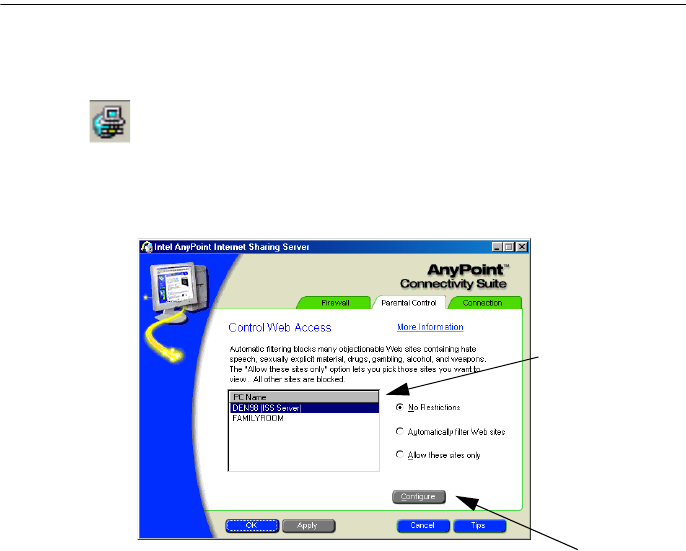
CHAPTER 2 Set Up the AnyPoint™ Wireless II Network
24
Configure Parental Control
To configure Parental Control:
1Double-click the ISS icon to open ISS.
2Click the Parental Control tab.
3Type the password, if prompted. You are prompted for a password only
if you entered one while running the Setup program. Remember, the
password is case-sensitive.
Set up exceptions to automatic filtering
The automatic filtering mechanism in Parental Control blocks sites based
on its analysis of their content. Sometimes innocent sites (news sites, for
example) include language or other content that looks suspicious to the
software, so it blocks them. If Parental Control blocks sites you want a PC
to be able to visit, you can configure Parental Control to ignore those sites.
To set up exceptions for automatic filtering:
1From the list of PCs in the Parental Control tab, click the one you want
to configure.
Choose the type of Web access control for
that PC:
•To disable Parental Control for the
selected PC, keep the setting at No
restrictions (default).
•To block material in predefined
categories, click Automatically filter
Web sites.
•To allow access to only specific Web sites,
click Allow these sites only.
To specify exceptions to
automatic filtering or to set up
the Web sites that this PC can
visit, Click Configure. See
“Set up exceptions to
automatic filtering” later in this
chapter for more information.
From the list of
PCs, click the
one you want to
configure.
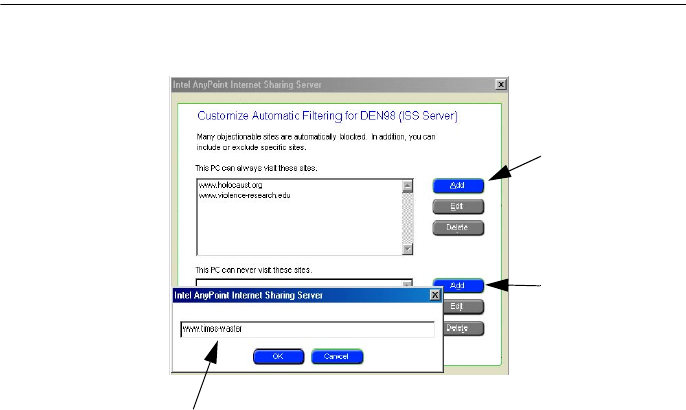
Set Up the AnyPoint™ Wireless II Network CHAPTER 2
25
2Click Automatically filter Web sites, and then click Configure.
Configure a PC to visit only certain Web sites
You may want to allow a PC to visit only specific Web sites, regardless of
how Parental Control would normally handle the sites. For example, you
might want the PC for a child or employee to be restricted to visiting sites
in a favorites list that you define for its Web browser. It’s important to
remember that Parental Control blocks access to all sites except the ones
you specify, but does not filter the sites you specify with its normal
restriction methods.
To configure a PC to visit only certain Web sites:
1From the list of PCs, click the one you want to configure.
2Click Allow these sites only, and then click Configure.
3Once you see the configure screen, click Add to set up the sites the PC
can visit.
4Type the Web address (URL), and click OK.
Click Add to set
up the sites the
PC can visit.
Click Add to
specify sites you
want to block.
Type the Web
address (URL),
and click OK.
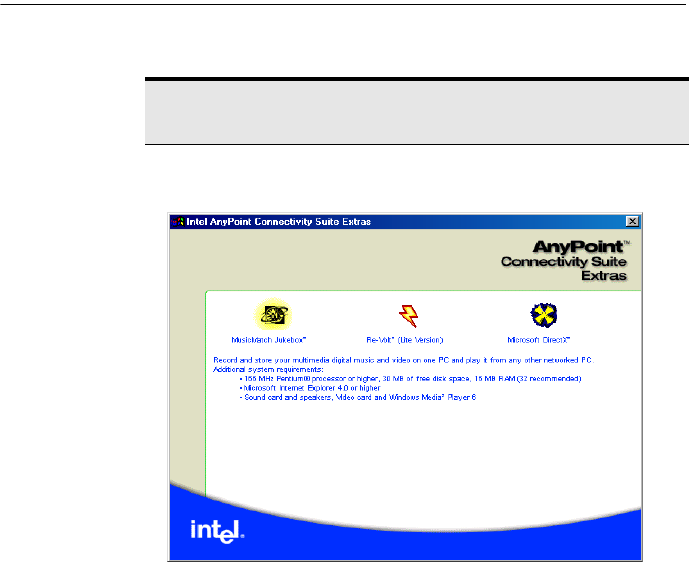
CHAPTER 2 Set Up the AnyPoint™ Wireless II Network
26
Set up AnyPoint Connectivity Suite Extras
Click Start > Programs > Intel AnyPoint Network > AnyPoint Extras to
select the AnyPoint Connectivity Suite extras:
Registration
From the PC that you have designated as the server, a registration screen
appears in a day or so. It asks you questions that help us serve you better in
the future. If you wish, you can fill it out at a more convenient time.
Note: The extras you receive will vary, depending on your
operating system and the AnyPoint software version in your PC.
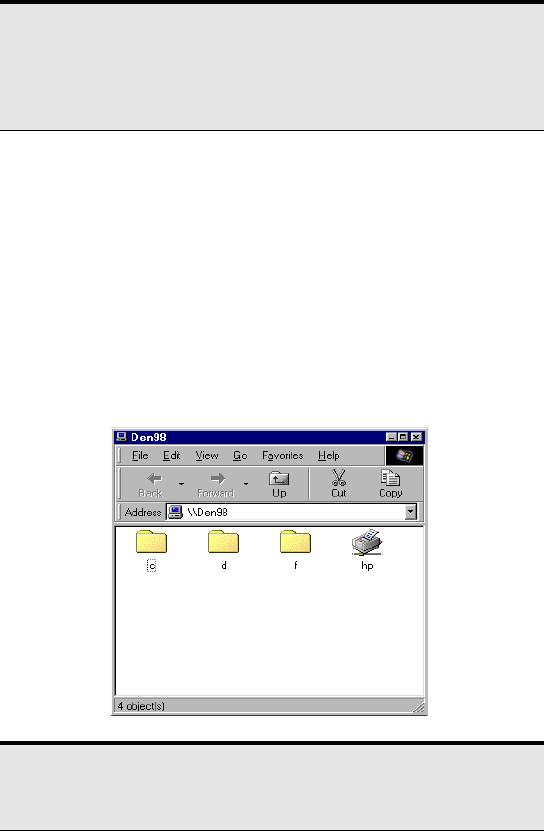
27
. . . . . . . . . . . . . . . . . . . . . . . . . . . . . . . . . .
Share Drives and Printers
3
This chapter explains how to use and change shared drives and printers
after you’ve set up the AnyPoint™ Wireless II Network. For conceptual
information, see "What is sharing and mapping?" on page 8.
Use network drives
See "What is
sharing and
mapping?" on
page 8.
When a PC shares a drive, other users on the network can share information
on the drive as though it were directly attached to their PC. When you map
to a shared drive, you allow your PC to access shared drives on other PCs in
your network.
For example, to view the shared drives and printers on your home network,
double-click Network Neighborhood on the desktop. Double-click the icon
for a PC to see that PC’s shared drives and printers. In this example, the
Kitchen PC is sharing drives C and D and a printer.
Note: Windows* 2000 users can set different mapping
configurations for separate accounts so that they can use a laptop
at home on one account and use the other account at work. Refer
to "How do I use my Wireless II laptop in different locations?" on
page 5 for more information.
Note: For Windows 2000 and Windows Millennium Edition
(Windows Me) users, when you are instructed to look in Network
Neighborhood, look in My Network Places.

CHAPTER 3 Share Drives and Printers
28
It may take several minutes for the PC to appear in Network Neighborhood.
If it does not appear, see "I can’t see a network PC from another PC" on
page 51.
You can view the mapped drives on your own PC by looking in the
following places:
•Network Neighborhood
•My Computer
•Windows desktop icons (shortcuts)
•Open and Save file dialog boxes
•Sharing and Mapping Software
•Windows Explorer
Use files across the network
When you have access to drives from other PCs on the network, you can
open files as though the drive is physically attached to your PC.
Viewing video files across the network
Video files that you download off the Internet (or create with a PC camera)
can be viewed on most connected PCs. PCs with less than 32MB of RAM
may experience problems viewing video. PCs with Pentium II processors
(and later versions) using 64 MB RAM (or more) and Windows Media
Note: If you are a Windows 2000 user and have installed the
AnyPoint Connection Manager (ACM), the sharing and mapping
software only shares information for the drives when it detects an
AnyPoint adapter in the active profile. With a different network
profile, different shared drives are visible.
Drive access
What you can do with
the other PC’s drive Shared - Full Shared -
Read Only Not Shared
Open files on this drive yes yes no
Save files on this drive yes no no
Copy files to this drive yes no no
Copy files from this drive yes yes no
Delete files on this drive yes no no
Print files on this drive yes yes no

Share Drives and Printers CHAPTER 3
29
Player (default on most Windows PCs and available for free download
from Microsoft’s website) are recommended. Simply open Windows
Explorer and double-click on the video file you wish to view.
Certain video formats may require installation of additional software called
a codec (compression/decompression). The codec allows the PC to
uncompress the video format, such as the DiVX codec for certain MPEG4
videos. You can use Media Player to automatically download and install
many of these codecs for you.
Change drive sharing and mapping
When you first view the Sharing and Mapping screens, the following
defaults are applied to your drives:
•All drives are shared except diskette drives.
•All shared drives have Shared - Read Only access.
•All shared drives are mapped.
Change drive access
Changing access to your drives will allow (or prevent) others from
changing files on your PC.
To change drive access (at the PC physically attached to the drive):
1Click Start > Programs > Intel AnyPoint Network > Sharing and
Mapping Software.
2On the Share Drives with Other PCs screen, right-click the drive you
want to change access.
3Select the access level you want to assign to the selected drive (Shared,
Shared - Read Only, or Shared - Full).
4Click Next until the Finish button appears, then click Finish.
Note: Third party software, such as SnapStream PVS*
(www.snapstream.com), offers additional video sharing and TV
recording capabilities and makes sharing video content on your
Wireless II network simpler and more enjoyable.”

CHAPTER 3 Share Drives and Printers
30
Change drive mapping
To change mapping for a specific drive (at the PC from which you
access a shared drive):
1Click Start > Programs > Intel AnyPoint Network > Sharing and
Mapping Software.
2Click Next until the Map Drives on other PCs screen appears.
Select the drive and then click the appropriate arrow (right or left)
when you want to move it from one box to the other. For example, if
you do not want to map the Kitchen’s C drive, select it, then click the
right arrow to move it from the Mapped Drives box to the Unmapped
Drives box.
3Click Next until you have finished mapping drives. Then, click Finish.
Change printer sharing and mapping
You can use the AnyPoint Sharing and Mapping Software to change how
you share and map printers with other networked PCs.
Change printer sharing
To change printer sharing (at the PC physically attached to the printer):
1Click Start > Programs > Intel AnyPoint Network > Sharing and
Mapping Software.
2Click Next until the Share Printers with Other PCs screen appears.
3Right-click the printer you want to change.
4Select Shared to share a printer. Select Not Shared to stop sharing.
5Click Next until you have completed sharing printers. Then click
Finish.
Change printer mapping
To change printer mapping (at the PC from which you want to use the
network printer):
1Click Start > Programs > Intel AnyPoint Network > Sharing and
Mapping Software.
2Click Next until the Map Printers on other PCs screen appears.
Note: If your PC detects new drives or printers to share or map,
the AnyPoint Sharing and Mapping Software runs automatically.

Share Drives and Printers CHAPTER 3
31
3Select the printer from the Unmapped Printers box and click the left-
arrow button to move it to the Mapped Printers box.
4Windows starts the Add Printer Wizard. Make sure you have the
driver disk(s) for the printer (you may need them). To add the printer
driver, follow the instructions on the screen.
5To map another printer, repeat steps 3 and 4.
6On the Map Printers on other PCs screen, Click Finish.
Install printer drivers
To map a network printer, its printer driver must be installed on each PC
that will print to that printer. The printer driver is software that enables your
PC to communicate with that particular kind of printer.
When mapping a printer, the Sharing and Mapping Software automatically
runs the Windows Add Printer Wizard and tries to copy the printer drivers
from the PC attached to the printer. If this doesn’t work, you may need to
install the printer drivers manually using the printer software.
Some printers come with custom installation software. These printers do
not use the Windows Add Printer Wizard to install and configure the
printer. To map a printer that uses custom installation software, first
manually install the printer software on each PC that will use the printer.
Refer to the printer documentation for installation procedures.
Unmap a printer
To unmap a printer (at the PC that no longer needs access to the
network printer):
1Click Start > Programs > Intel AnyPoint Network > Sharing and
Mapping Software.
2Click Next several times until the Map Printers on other PCs screen
appears.
3Click the printer in the Mapped Printers box then click the left-arrow
button to move it to the Unmapped Printers box.
4To unmap another printer, repeat step 3; otherwise, click Finish.
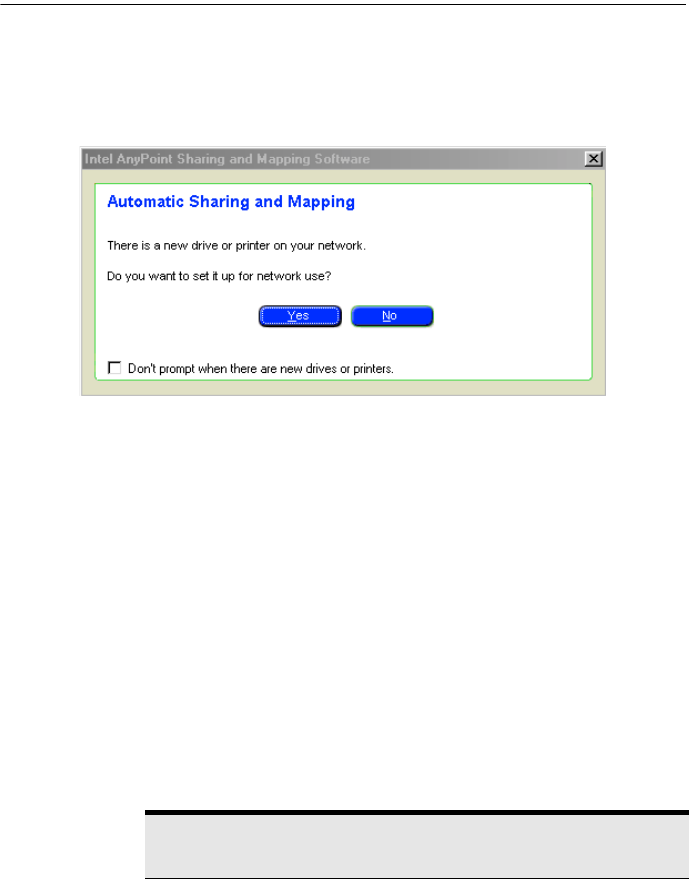
CHAPTER 3 Share Drives and Printers
32
Share and map automatically
When new drives or printers are added to your network, the AnyPoint
Sharing and Mapping software detects them and automatically offers you
the opportunity to share or map them.
To disable automatic sharing and mapping:
Click Don’t prompt when there are new drives or printers in the message
box.
To enable automatic sharing and mapping:
1Click Start > Programs > Intel AnyPoint Network > Sharing and
Mapping Software.
2Click the system menu in the upper-left corner of the title bar, and click
Automatic Prompt.
Multiple user profiles
Multiple user profiles let different people who use the same PC customize
their Windows settings. A user profile becomes active when the user logs
on to the network at a PC with multiple user profiles turned on, using his or
her unique user name and password.
To find out if your PC has multiple user profiles, click Start > Settings >
Control Panel > Passwords > User Profiles tab. If All users of this
computer use the same preferences and desktop settings is selected,
multiple user profiles are turned off.
Note: If a PC has multiple user profiles, each user must map the
network drives they want to access.

Connect to the Internet CHAPTER 4
33
. . . . . . . . . . . . . . . . . . . . . . . . . . . . . . . . . .
Connect to the Internet
4
With AnyPoint™ Internet Sharing Software (ISS), you can connect to the
Internet on multiple PCs at the same time, all with just one modem and one
Internet or broadband cable account. The PC with the Internet connection is
called the ISS server, and all the other PCs on the network that are sharing
the Internet account through the ISS server are called ISS clients.
Connect to the Internet using ISS
To see if ISS is running on the ISS server, look for the ISS icon on the right
side of the Windows* taskbar. If the icon is present, ISS is running.
If the icon is not present, you can manually start ISS on the server by
selecting Start > Programs > Intel AnyPoint Network > Internet Sharing
Server.
Connect from the ISS server
To connect from the ISS server:
1Make sure that ISS is running on your ISS server PC.
2Start an Internet browser (such as Netscape Navigator* or Microsoft
Internet Explorer*), and ISS automatically connects you to the Internet.
Important: If you have installed your AnyPoint Wireless II adapter
into a network through an access point or a gateway, ISS and its
features are not available. Refer to documentation for those
devices for instructions on connecting to the Internet.
Note: If you are using Virtual Private network (VPN) software, refer
to "Connecting with Virtual Private Network (VPN)" on page 37.
Refer also to the AnyPoint Wireless II Network Online Support site,
www.intel.com/anypoint/support/ for information.
Note: To close the shared Internet connection from the server PC,
double-click the ISS icon in the status area of the Windows taskbar,
and select Hang Up.

CHAPTER 4 Connect to the Internet
34
Connect from an ISS client
1Make sure the ISS server PC is turned on and that ISS is running.
Even though the server PC does not need to be connected to the
Internet, it does need to be running ISS.
2At the ISS client, start any Internet program (such as a web browser).
ISS automatically connects the ISS server to the Internet and shares the
connection with the ISS client. If AOL*, AT&T WorldNet*,
CompuServe* 2000, Gateway.net*, or Prodigy* is your Internet
Service Provider, see "Internet Service Provider Reference" on page 63.
Reading mail after connecting to ISS
When your server and client PCs are connected to ISS, keep the following
notes in mind:
•Only your server PC needs to connect to your primary Internet Service
Provider (ISP).
•The client PCs do not need to have a modem for you to read e-mail; just
run the mail application and mail is retrieved through the ISS server.
During installation of ISS, you can configure your mail application to
connect to a LAN and not a dial-up connection.
•You can download e-mail from a server or a client PC.
•Utilize a common “Mbox” on your network so that all PCs can view all
e-mail. refer to your email documentation for details.
Disconnect or hang up from the ISS server
1Double-click the ISS icon and click Hang Up.
2If you can’t hang up the Internet connection by clicking Hang Up, exit
ISS to close the connection.
3Restart the ISS server from the Start menu.
Note: You cannot hang up a continuous connection like DSL or
cable modems.

Connect to the Internet CHAPTER 4
35
Disconnect or hang up from an ISS client
From an ISS client, you can close the shared connection only if the settings
on the ISS server allow any PC to hang up. When any PC hangs up the
shared connection, the connection closes for all PCs on the network.
•To disconnect or hang up from an ISS client without hanging up the
shared connection, quit all Internet programs on the ISS client.
•To end the network’s shared Internet connection and disconnect all
PCs, double-click the ISS icon, and click Hang Up. If Hang Up is not
available, the ISS server has not granted permission for clients to end
the connection, or, in the case of continuous connections like cable
modems and DSL lines, you cannot disconnect the connection.
Exiting or bypassing ISS when connecting to the
Internet
If you need to connect your PC to the Internet without using the AnyPoint
Internet Sharing Software, use these instructions to exit or bypass ISS.
Choose one of two methods of connecting to the Internet without ISS:
•Exit ISS from the ISS server to prevent all PCs on the network from
using the shared Internet connection, or
•Bypass ISS from any PC. This bypasses ISS only on that PC.
None of the ISS services are available in this mode of operation.
Exit ISS from the ISS server
To prevent all PCs on the network from using the shared connection, quit
ISS at the ISS server. This closes the ISS window and disconnects all
network PCs from the shared Internet connection.
To quit ISS:
1At the server PC, right-click the ISS icon on the right side of the
Windows taskbar.
2Click Exit.
ISS starts again when you restart the ISS server PC or when you start ISS
manually at the ISS server.
Note: If your network uses a gateway or an access point, refer to
the documentation for these devices for connecting to the Internet.

CHAPTER 4 Connect to the Internet
36
Bypass ISS from any PC
You can bypass ISS at either an ISS client or at the ISS server. You might
want to bypass ISS in order to play a non-Internet game with another PC on
your AnyPoint™ Wireless II Network. To bypass ISS, right-click the ISS
icon on the taskbar, and click to deselect Internet Programs Connect
Through ISS.
To undo the ISS bypass and share the Internet connection, right-click the
ISS icon in the status area, and click to select Internet Programs Connect
Through ISS.
View connection status and settings
To view the connection settings and status at any PC, double-click the
ISS icon, then click the Connection tab.
You can view the connection status and settings from either the ISS server
or an ISS client, but you can change the settings only at the ISS server.
Change the ISS server
You can either add a new PC to the network and designate it as the ISS
server or you can make an existing ISS client the ISS server. Remember
that the ISS server must have a way to connect to the Internet. If possible,
you should choose the PC with the fastest Internet connection as the server.
There can be only one ISS server on the network.
Note: ISS clients can use the shared Internet connection even
when the server PC has bypassed ISS.
Note: If you have questions about connecting to the Internet, you can
refer to the AnyPoint Wireless II Network Online Support site,
www.intel.com/anypoint/support/.
Note: If you bypass ISS and then restart the PC, ISS remains
bypassed. Click the ISS icon in the service tray to re-enable.

Connect to the Internet CHAPTER 4
37
To change the ISS server:
1At each PC, click Start and then click Shut Down.
2If there is already an ISS server on the network, reinstall the AnyPoint
software on the ISS server, and choose ISS client in the server/client
setup screen.
3Turn on the PC that you want as the new ISS server.
4Install (or reinstall) the AnyPoint software on the new server PC, and
choose ISS server in the server/client setup screen.
5Restart the new ISS server.
6Restart the other PCs on the network.
Connecting with Virtual Private Network (VPN)
A VPN is an encrypted network that provides a secure private connection,
usually for a corporate network. If you use VPN, note the following:
•We recommend an 802.11b Wireless Gateway, which works with most
VPNs. See www.intel.com/anypoint for more information.
•Without a gateway, install the AnyPoint Connectivity Software Suite,
but choose not to install Internet Sharing Software when prompted. If
users have a Win98 SE (or higher), install Microsoft’s ICS to share
Internet access.
•Do not install the VPN client software on the same computer as the ICS
server (the computer with the Internet connection).
With these considerations in mind, refer to your VPN manual for
installation instructions.
Important: If you use or plan to install a VPN, you will not want to
install Internet Sharing Software (ISS). To optimize your network
with VPN, you may want to consider purchasing a Wireless
Gateway or use Microsoft’s Internet Connection Software (ICS)
provided with windows.
If you need more information on VPN, check the AnyPoint Wireless
II Network Online Support site at:
Important: www.intel.com/anypoint/support/

CHAPTER 5 Managing your Wireless II Network
38
Managing your Wireless II
. . . . . . . . . . . . . . . . . . . . . . . . . . . . . . . . . .
Network
5
When you installed your AnyPoint™ Wireless II adapter, you configured
your adapter settings to work in your primary network. For desktop PCs,
you rarely need to change these settings. For laptop PCs that you want to
use in different locations, you need to change the settings everytime you
connect to another network.
This chapter describes various tasks you might encounter when managing
your Wireless II network.
Using the AnyPoint Connection Manager
You can use the AnyPoint Connection Manager to edit wireless settings,
create profiles, and connect to any network profile. You can use one of two
tabs:
Wireless Control Panel tab
Use the Wireless Control Panel (WCP) tab to view or edit current
wireless settings, such as Network ID code (SSID), Mode (Peer-to-peer or
Infrastructure), channel, header, and encryption keys. This tab is the first
screen you see when you open the AnyPoint Connection Manager.
On desktop PCs, you can view and edit the settings on this tab when you
are changing your network, such as adding a new PC or gateway. On laptop
PCs, you can easily change settings on this tab to connect to a different
network.
Profile Manager tab
Use the Profile Manager tab to create, edit, and switch profiles. Profiles
contain all the wireless settings and operating system settings such as
shared drives, printers, browsers, TCP/IP addressing, and windows
settings. You can also use this tab to Scan for other networks. See Scan for
public access points on page 42 for details.
Note: For a description of all networking concepts, refer to
Understanding your AnyPoint™ Wireless II Network on page 1.
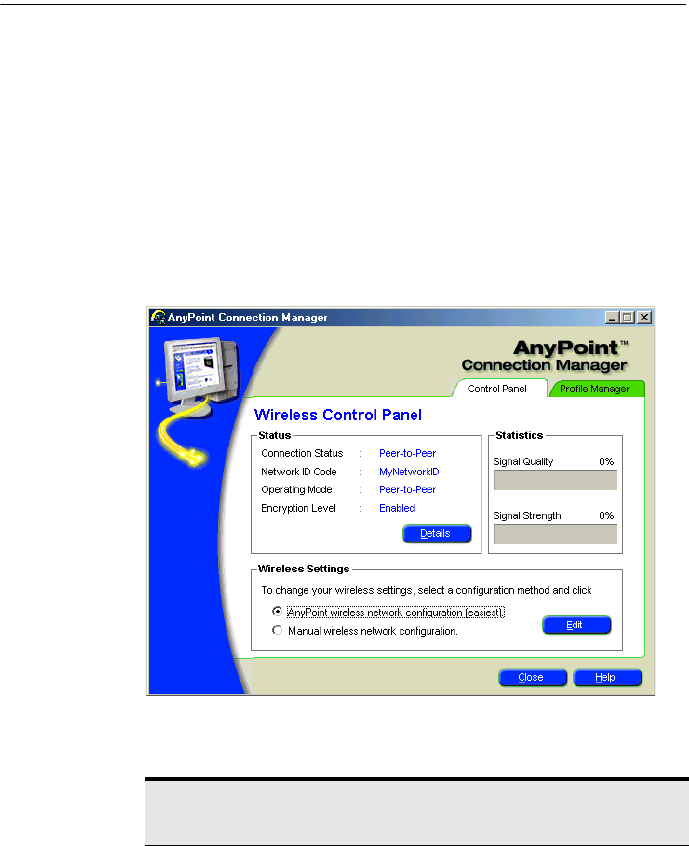
Managing your Wireless II Network CHAPTER 5
39
You may use this tab frequently if you carry your laptop from home to work
or to public access points. It provides a wizard for changing basic settings.
Once you select and connect to a given profile, the connection manager
software loads the appropriate settings.
View and edit current settings using the Wireless
Control Panel tab
You can view and edit current wireless settings using the Wireless Control
Panel. When you open the AnyPoint Connection manager, you see the
Control Panel tab.
The Wireless Control Panel shows you Status, Statistics, and Wireless
Settings.
•Status - Shows the basic connection settings. The settings include
network ID code, operating mode, and encryption. If you click Details,
you will see additional wireless settings.
•Statistics:
•Signal strength - This provides an indication of how well your
adapter is receiving and transmitting radio signals. To maximize the
signal strength, you can move your laptop PC to various locations of
your room, or you can adjust the antenna on your USB adapter.
Note: To get more details for each of the settings, click Help on the
Wireless Control Panel screen.
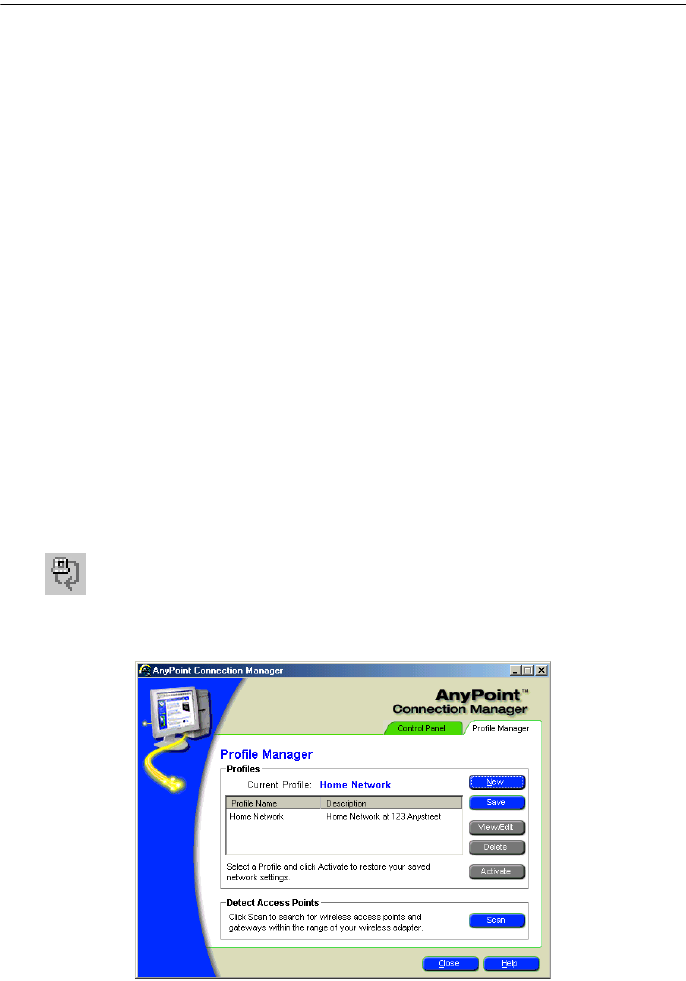
CHAPTER 5 Managing your Wireless II Network
40
•Signal quality - This provides an indication of how much
background noise is interfering with your signal. Poor signal quality
may mean you are too close to a microwave or cordless phone in
operation.
•Wireless settings - Provides an Edit button to modify your settings. If
you want to edit settings for a network that has all AnyPoint devices,
select AnyPoint wireless network. You will see a series of Wizard
screens with current values. You can change any value in the screens.
Or, if you want to edit settings for a network does not have all
AnyPoint devices, choose Manual wireless network configuration.
Once you make your changes, click Finish to keep all changes.
Activate a profile
The Profile tab of the AnyPoint Connection Manager lists all available
profiles on your computer. When you installed your adapter, the profile
manager automatically created a default profile, named AnyPoint. Each
time you create a new profile, the name is added to the list on the Profile
Manager tab.
To activate an existing profile on your Profile Manager tab:
1Click Start > Programs > Intel AnyPoint Network > AnyPoint
Connection Manager. You can also click the AnyPoint Connection
Manager icon in the lower right service tray.
2Click Profile Manager. The Profile Manager screen and the list of
current profiles will appear.
3Click one of the profiles listed under the Profile Name column.

Managing your Wireless II Network CHAPTER 5
41
4Select Activate then Close. Your computer will load the settings for the
selected profile and reboot if necessary.
Creating a new profile
If you plan to use your laptop in several networks, you can create a profile
for each network. All profiles contain the wireless and operating system
settings including:
•profile name
•profile network configuration type
•network mode
•encryption
•Windows network settings
What are the profile configuration types?
With your Wireless II network, there are two ways to configure profiles:
1 AnyPoint wireless network configuration - Choose this profile type if
your network uses only AnyPoint Wireless II devices. This profile type
is the easiest to create. The profile wizard merely asks you for a name
and password, and an encryption code. Using your input, the software
defaults the other settings.
2 Manual wireless network configuration - Choose this profile type if
your network includes any wireless adapter (using 802.11b technology)
other than an AnyPoint Wireless II adapter. In this case, the profile
wizard prompts you for more input for specific 802.11b settings.
What are the profile modes?
When you create a profile, you will select one of two profile modes: Peer-
to-Peer (or ad hoc) mode or the Infrastructure mode.
Before you can make that decision, you must know which type of profile
you want to create. To help you decide, consider the following options.
Configure an Infrastructure profile if you want to connect:
•to a public access point, such as an airport or coffee house.
•to a home or small office network with a gateway.
•to a corporate wired network or in a network that uses a gateway.
Configure a Peer-to-Peer profile if you want to connect to:
•a home or small office network with only PCs (and no gateway).
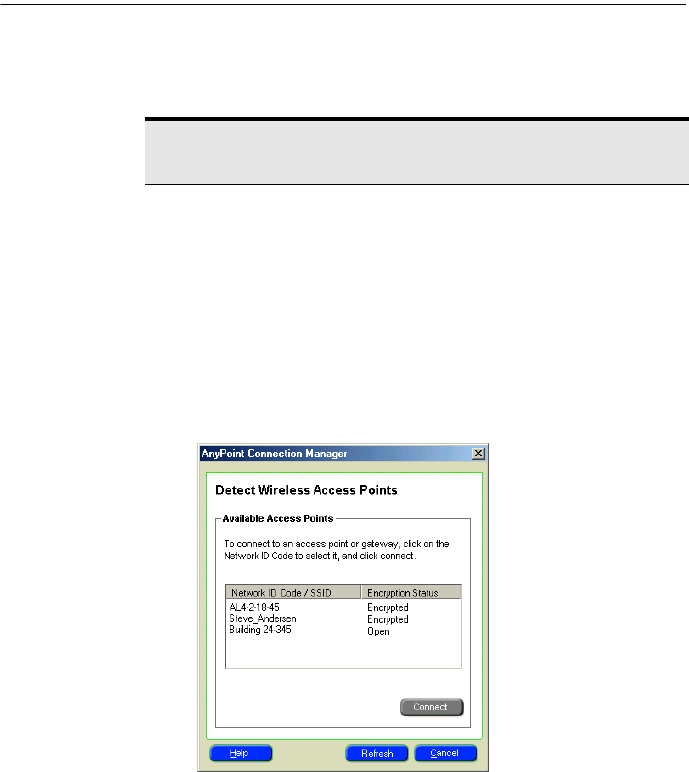
CHAPTER 5 Managing your Wireless II Network
42
Refer to one of the remaining sections that best represents the type of
network profile you want to create. The steps in each section help you
select profile type, mode, and 802.11b settings for each.
Scan for public access points
The Profile Manager tab of the AnyPoint Connection Manager includes a
button to scan for access points. If you want to see if any access points are
in range of your adapter, click the Scan button.
To scan for public access points:
1From the Profile Manager tab of the AnyPoint Connection Manager,
click Scan. The Detect Wireless Access Points screen appears. You
will see a listing of all access points in the area.
2Click the access point you want to connect to.
3Click Connect to obtain all the settings for that access point. If
encryption is not needed for the access point, the Detect Wireless
Access Point screen disappears and you will be connected.
Note: For information explaining the technical differences between
the mode variations, see page 3.
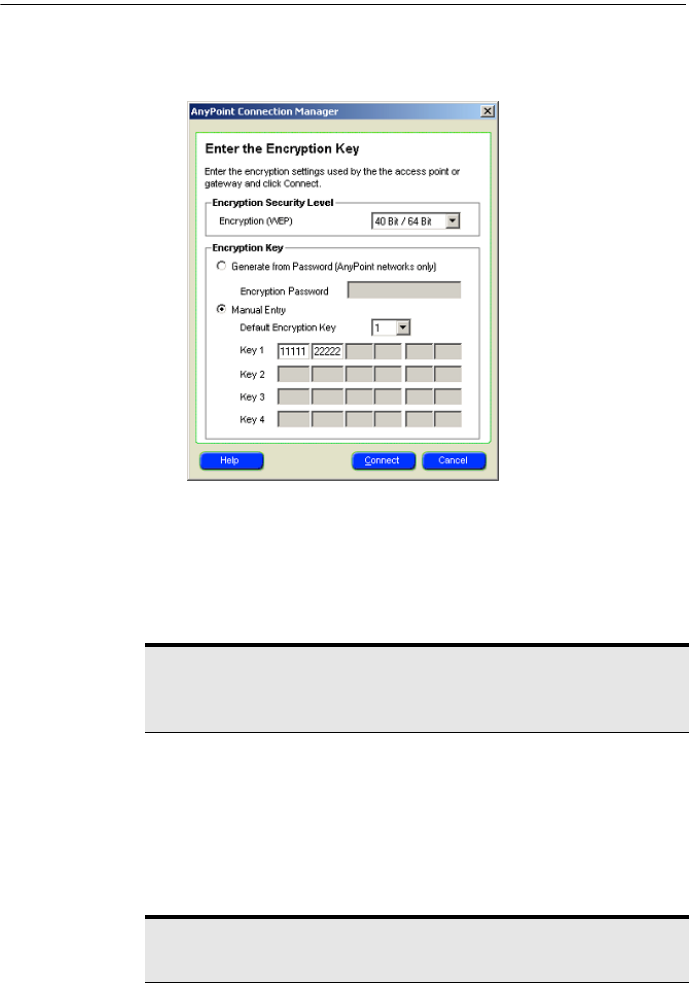
Managing your Wireless II Network CHAPTER 5
43
If the network has encryption, you will see the Enter the Encryption
Key screen.
If you are accessing an AnyPoint network, you can enter a password. If
not, manually enter the Encryption number and key for the access
point.
Create a profile for a public access point
The following instructions help you to create a profile that connects your
laptop to a public access point.
The administrator for the network must provide you with the values of all
the settings, like the network ID code (SSID), channel, and encryption
codes. Open the AnyPoint™ Connection Manager and use the following
instructions to start a new profile and enter those settings.
Note: These instructions represent an example of an infrastructure
network. For conceptual information, refer to Infrastructure mode on
page 4.
Note: For any screen or dialog box that appears on your monitor,
you can click Help to provide more information.
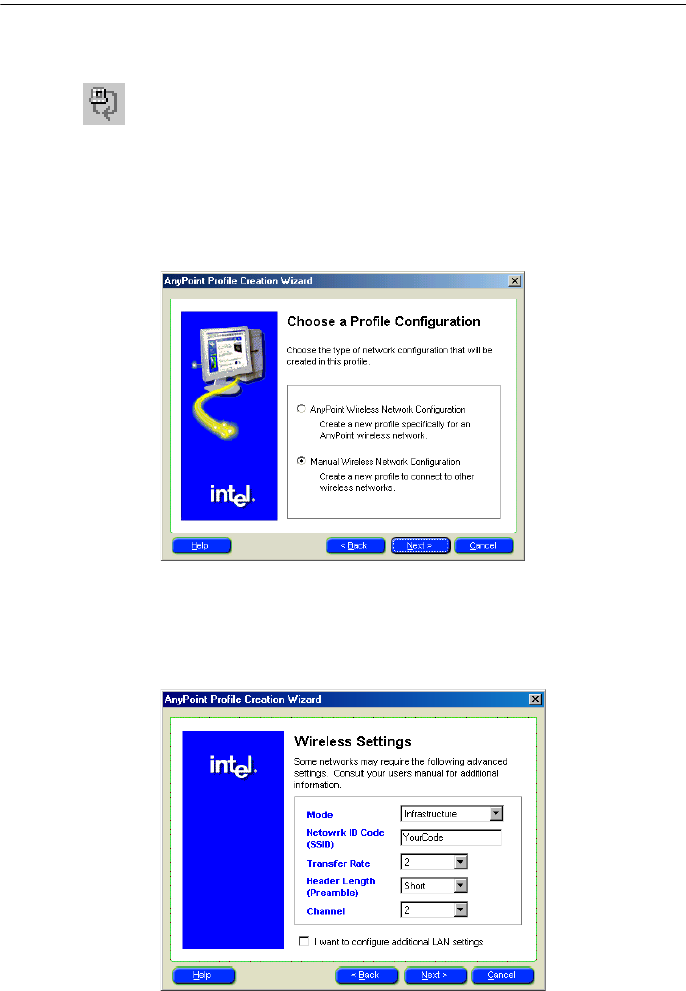
CHAPTER 5 Managing your Wireless II Network
44
To create a profile connecting your PC to an access point (AP):
1Click Start > Programs > Intel AnyPoint Network > AnyPoint
Connection Manager. Alternatively, you can click the AnyPoint
Connection Manager icon in the service tray.
2Click the Profile Manager tab. You will see the Profile Manager screen
and the list of current profiles.
3Click New. The Create New Profile screen appears.
4Type a Profile name for your new profile, a brief Description, then
click Next. The Choose a profile Configuration screen appears.
5Since you are creating a profile for a network that uses an access point,
a gateway, or adapters that are not Anypoint Wireless II adapters, select
Manual Wireless Network Configuration.
6Click Next. The Wireless Settings screen appears.
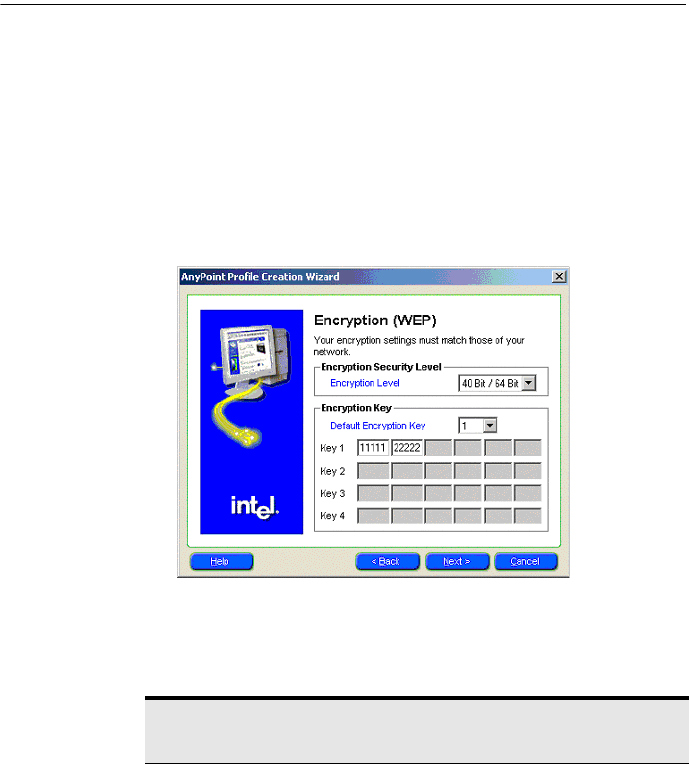
Managing your Wireless II Network CHAPTER 5
45
Enter these settings:
•Mode
•Network ID code (SSID)
•Transfer Rate
•Preamble (or header)
•Channel
For a description of each, click Help.
7Click Next. The Encryption (WEP) Key screen appears.
8Select the encryption security level (either 40/64 bit or 128 bit). Select
the default encryption key (a number from 1 to 4). Then enter the
encryption key in hexadecimal characters. For more information, click
Help.
9Click Next. The Finish screen appears. Click Finish to add your profile
to the profile list of the AnyPoint Connection Manager.
If you want to activate the profile immediately, go to the AnyPoint
profile Manager tab, select the profile you created and click Activate. If
you want to wait and connect later, refer to Activate a profile on
page 40.
Note: The Hexadecimal character set consists of alpha-numeric
characters 0 through 9 and A through F.
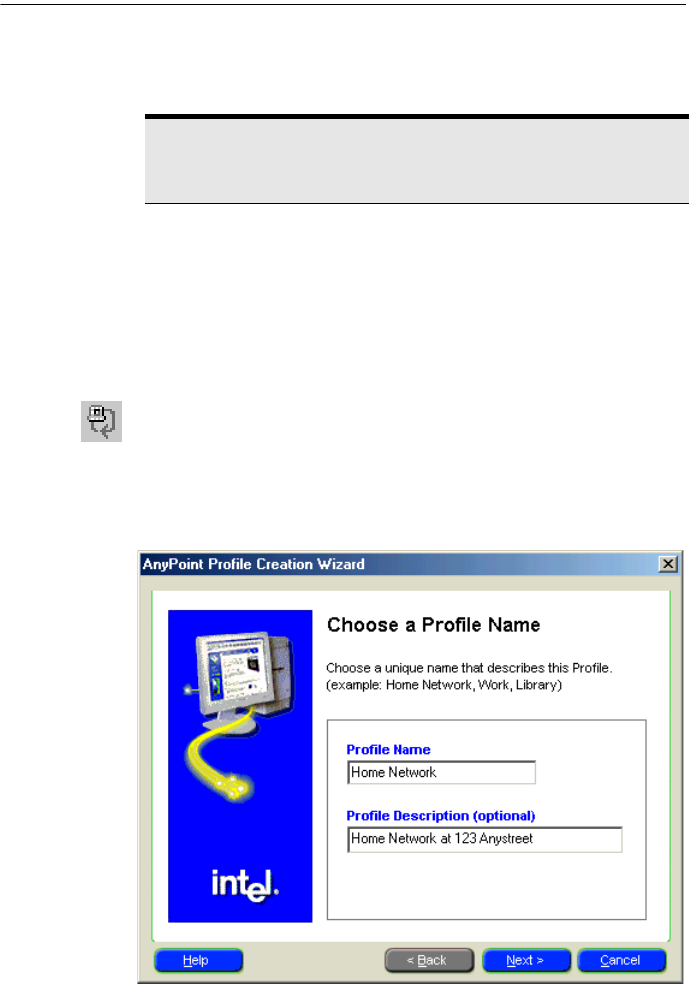
CHAPTER 5 Managing your Wireless II Network
46
Create an AnyPoint profile for your home or small
office
The following instructions help you create a profile to use in your home or
small business office. These instructions illustrate a Peer-to-Peer network.
For conceptual information, refer to Peer-to-Peer mode on page 3. Use
these instructions if you are creating a profile that uses only AnyPoint
devices.
To create a new AnyPoint profile.
1Click Start > Programs > Intel AnyPoint Network > AnyPoint
Connection Manager. Alternatively, you can click the AnyPoint
Connection Manager icon in the service tray
2Click the Profile Manager tab. You will see the Profile Manager screen
and the list of current profiles.
3Click New. The Choose a Profile Name screen appears.
Note: These instructions do not cover installing home or small
office networks with gateways or access points. See the
instructions in the documentation for those devices.
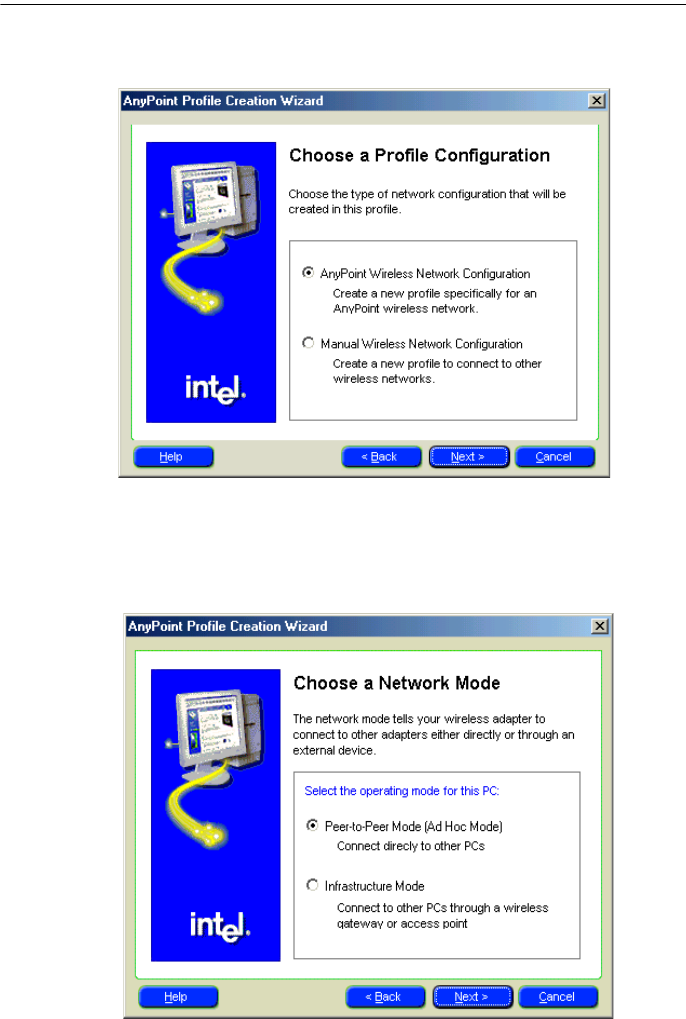
Managing your Wireless II Network CHAPTER 5
47
4Type a Profile Name for your new profile, a brief Profile Description,
then click Next. The Choose a Profile Configuration screen appears.
5Select the AnyPoint Wireless Network Configuration type (only if all
devices in your network are AnyPoint hardware). Click Next. The
Choose a Network Mode screen appears.
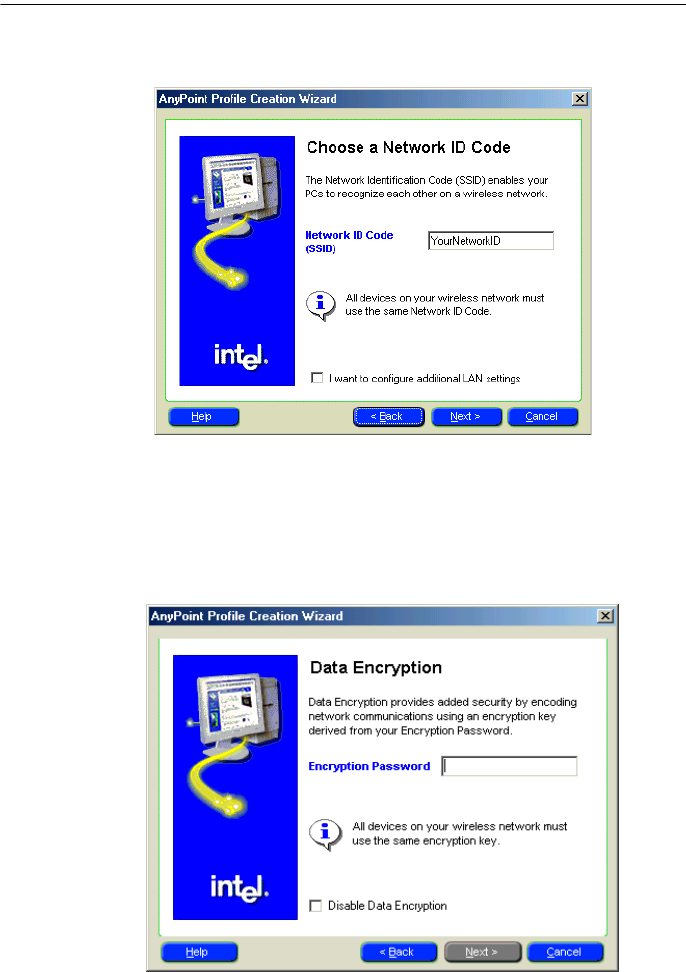
CHAPTER 5 Managing your Wireless II Network
48
6Select Peer-to-Peer (Connect directly to other PCs) and click Next.
The Choose a Network ID Code screen appears.
7Create and type a unique network ID code (SSID). The code you create
must be 32 characters or less. The code is case-sensitive. Use this same
code for all the PCs in the network. Make sure the I want to configure
additional LAN settings box is left unchecked.
8Click Next. The Data Encryption screen appears.
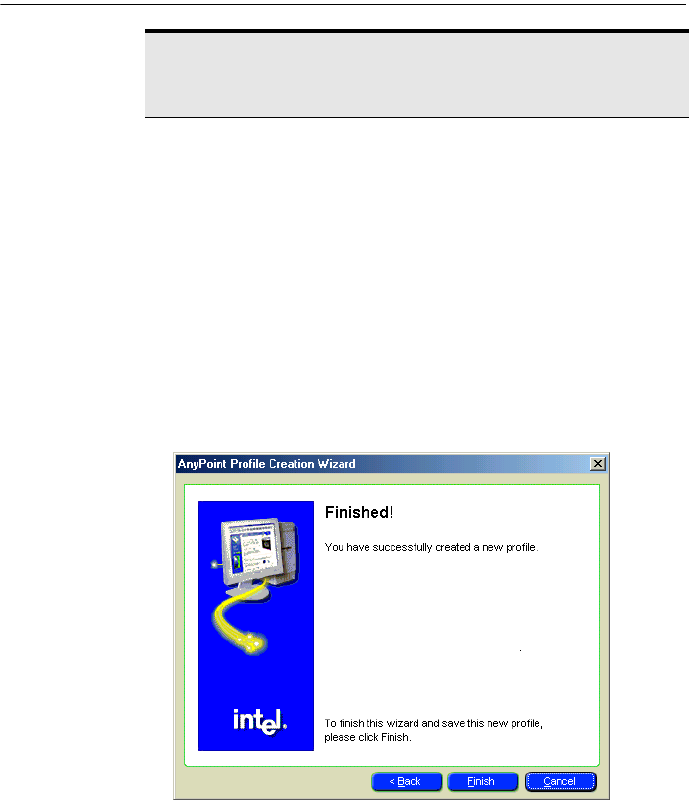
Managing your Wireless II Network CHAPTER 5
49
Create and type an encryption password. The code you create must be
32 characters or less. The code is case-sensitive. Enter the same code
for all the peer PCs in the network.
For more information describing the encryption password, see What
are Wireless II adapter and operating system settings? on page 6.
If you are not concerned with security of your transmitted data, check
the Disable Data Encryption box. This will slightly increase the
performance of any data transfer between PCs. Unchecking the box
will slightly decrease the performance, but will increase security. We
recommend leaving the box unchecked. Click Next. The Finished
screen appears.
9Click Finish. Your profile will be added to the existing Profile
Manager tab of the AnyPoint Connection Manager.
If you want to activate the profile immediately, go to the AnyPoint
profile Manager tab, select the profile you created and click Activate. If
you want to connect later, refer to Activate a profile on page 40.
Important: Data Encryption is the method that the wireless
communications industry uses to ensure secure transmission of
your data. It is an 802.11b standard.

CHAPTER 5 Managing your Wireless II Network
50
Create a profile for a corporate wired network
In the office environment, laptops equipped with wireless network adapters
connect to the corporate network through an access point or gateway, which
acts as a bridge to connect your wireless laptop to the hard-wired
infrastructure of your office network. Often, access points are mounted on
walls or ceilings, so users can access the corporate network from any
location in the building or campus.
Once connected, your laptop functions in the same way on the corporate
network as it does using a wired connection.
Use AnyPoint Connection Manager to create your corporate network
profile. Your IT representative can provide values for any of the wireless
settings listed below.
•Profile Name
•Profile Description (optional)
•Profile Type
•Mode
•Network ID (SSID or ESSID)
•Transfer Rate (TxRate)
•Preamble (header) Length
•Channel
•Encryption Level (WEP)
•Encryption Password
•Manually entered encryption key (optional)
•IP Address (manual or auto assigned)
•DNS Server Address (manual or auto assigned)
•Automatically Detect Proxy Settings
•Automatic Proxy Configuration Script
•Use Proxy Server
•Do not use Proxy Server for Intranet
•Use Same Proxy Server for all Protocols
•Proxy Exceptions
Important: If you connect your laptop to a corporate network,
contact an MIS or IT representative.

51
. . . . . . . . . . . . . . . . . . . . . . . . . . . . . . . . . .
Troubleshooting
6
This chapter addresses some of the most common problems people have
with their AnyPoint™ Wireless II Network. If the information you need is
not here, check the AnyPoint Wireless II Network Online Support site at:
www.intel.com/anypoint/support/
I can’t see a network PC from another PC
First, make sure both PCs are turned on, and that the network adapters’
hardware and software are correctly installed. Follow these steps in order.
Make sure the adapters and cables are installed correctly
For information about installation and cables, refer to the Installation
Guide (the poster that came with your adapter).
Make sure you are logged on to the network
Restart all the PCs on the network. When Windows* restarts, the Enter
Network Password screen may appear, depending on your previous system
settings. If it does appear, type a new user name (or accept the default),
create a password (optional), and then click OK.
See page 15 for more information on user names and network passwords.
Make sure the PCs on the network are in the same workgroup
To verify work group settings:
1Click Start > Settings > Control Panel.
2Double-click Network.
3Click the Identification tab.
4Change the Workgroup setting to the same name on all PCs.
Do not click Cancel!
If you click Cancel, you will
not be on the network.

CHAPTER 6 Troubleshooting
52
Check the IP address and subnet mask on PCs running Windows*
95, Windows 98, and Windows Me
Most of the time, the AnyPoint software or Windows automatically sets the
IP address and subnet mask on your PC. If you have problems, you can
manually specify an IP address.
To verify an IP address and subnet mask for your adapter:
1Click Start then click Run.
2In the Run box, type “winipcfg” then click OK. The IP Configuration
screen appears,
3View the Intel AnyPoint Wireless II Adapter and verify that the
address is in the same subnet range (such as 192.254.10.10, subnet
255.255.255.0).
If you need to change the IP address, reference the following URL,
www.intel.com/anypoint/support, and read the document entitled, “I
want to change my adapter's IP (Internet Protocol) address.”
I have an insufficient permissions error when running
Windows 2000
Any user who is not a member of the Administrator’s group will not have
permissions to run the AnyPoint™ software.
To add the current user to the Administrator’s group:
1Log on as an administrator or as a member of the Administrators group.
2Click Start > Settings > Control Panel.
3Double-click Users and Passwords.
4Under Users for this computer, click the user you want to change and
then click Properties.
5On the Group Membership tab, click Standard user (Administrators
Group)
6Click OK to close all dialog boxes.
Note: For Windows 2000 Professional, view the IP address at the
command prompt. Then type the following: command
C:> ipconfig /all.
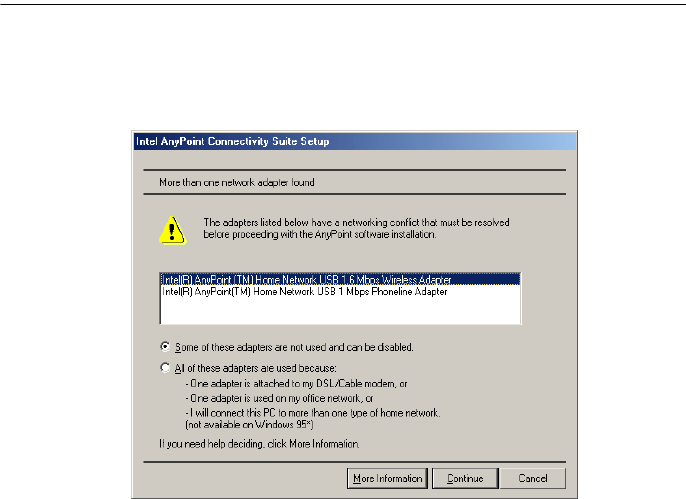
Troubleshooting CHAPTER 6
53
Remove incompatible network adapters
If the Setup program determines you have an additional network adapter,
the following screen appears.
To resolve the conflict between adapters:
1If you already know which adapter in the list can be disabled, select
Some of these adapters are not used and can be disabled. If you are
not sure which adapter to remove or you need all of the adapters listed,
go to step 4.
2If you have selected Some of these adapters are not used and can be
disabled, then click Continue. A screen showing the conflicting
adapters appears.
3Select the adapter you want to remove, click Disable and then click
Continue.
The Setup program continues with the software installation. Go back to
the Setup chapter, "Install the AnyPoint software" on page 11, and
continue with the instructions.
4If you selected All of these adapters used because, then click
Continue. A dialog box appears that provides more information to help
you decide which adapter to disable.
5Exit the Setup program and assign a different IP/Subnet address for the
the adapter. For instructions to do this, refer to the customer support
site: www.intel.com/anypoint/support/.
Once you reach the support site, find the topic “I want to change my
adapter IP address.”

CHAPTER 6 Troubleshooting
54
I can’t connect to my ISP from an ISS client PC
Try the following actions in order. After each step, try connecting to your
ISP. If your attempt is unsuccessful, go to the next step.
Make sure the ISS server PC is turned on and running the ISS
software
To tell if ISS is running, look for the ISS icon in the status area of the server
PC’s Windows taskbar.
Make sure both the ISS server and ISS client PCs are on the
network
To find out if both PCs are on the network, open Network Neighborhood on
the client PC. If you can see the ISS server PC, both PCs are on the
network. Otherwise, refer to "I can’t see a network PC from another PC" on
page 51.
If you are using AOL*, check the AOL software
At the ISS client PC, make sure the AOL* software is not running.
At the ISS server PC, check if you need to enter your AOL password or
close an advertising screen. If the server PC is waiting for user input on
either of these things you will not be able to connect at the client PC (see
"Set up America Online* (AOL*) with ISS" on page 63).
If you are using AT&T WorldNet*, or CompuServe 2000*, check
their settings
Make sure you have set up ISS to work with your ISP.
•AT&T WorldNet. See "Set up AT&T WorldNet* with ISS" on page 64.
•CompuServe 2000. See "Set up CompuServe* 2000 with ISS" on page
65.
Find out if the problem is ISS or your ISP connection
To rule out ISS as the problem:
1Use ISS to connect at the server PC. If you can connect to the Internet
from the ISS server PC, reinstall ISS on the client PC.
2If the problem persists, try to connect from the server PC without using
ISS. See "Exiting or bypassing ISS when connecting to the Internet" on
page 35.
•If you can connect to your ISP without ISS, reinstall ISS on the server
PC.
•If you can’t connect to your ISP with or without using ISS, the
problem is not ISS. Check your ISP connection settings.

Troubleshooting CHAPTER 6
55
I keep getting disconnected from the Internet without
hanging up
Check automatic hang-up settings
ISS has an automatic feature that hangs up a connection after a certain
amount of time with no Internet activity. Change the automatic hang-up
setting to wait for a longer amount of time.
Windows also has an automatic timeout setting. If necessary, change it so it
is longer than the ISS timeout setting.
To check automatic hang-up settings:
1Click Start > Settings > Control Panel, then double-click Internet.
2Select the Connection tab, and click Settings.
Check how long a connection can be idle before being disconnected. If
it is less time than the automatic hang-up setting in ISS, increase the
amount of time.
Verify that your ISP connection information is correct
Check the settings in the program you use for dialing your ISP.
Contact your Internet Service Provider
If none of these steps solves the problem, there may be a problem with your
ISP. Contact your ISP.
Can I use Internet sharing software from more than
one manufacturer?
No. All PCs on the network must run Internet sharing software from the
same manufacturer. See the next section for more information.

CHAPTER 6 Troubleshooting
56
ISS and ICS (Internet Connection Sharing)
Configuring your browser to use the Microsoft Internet
Connection Wizard
If the Microsoft Internet Connection Wizard starts when you run an Internet
program, make sure you select the option that says you already have an
Internet account on the computer when asked about the Internet
connection.
•In Internet Explorer* 3.0, select I already have an Internet connection
set up on this computer and do not want to change it.
•In Internet Explorer 4.0, select My computer is already set up for the
Internet. Do not show this wizard again.
•In Internet Explorer 5.0, select I want to set up my Internet
connection manually, or I want to connect through a local area
network (LAN).
Selecting any other option prevents ISS from working properly.
What is the difference between ISS and Microsoft’s ICS?
The AnyPoint Internet Sharing Software (ISS) enables all PCs on your
network to access the Internet through one shared connection. Microsoft’s
Windows 98 Second Edition has an optional feature, Internet Connection
Sharing (ICS), that provides similar capabilities.
Do ICS and ISS work together?
Yes, they can co-exist, but this is not recommended. Select one or the other.
See "How do I decide if I should use ISS or ICS?" on page 56.
How do I decide if I should use ISS or ICS?
If you have only Windows-based PCs on your network, use ISS and leave
ICS uninstalled. ISS provides better status reporting and control of the
shared connection. If you have other devices, such as a Macintosh* or PCs
running other operating systems or VPNs on your network, use ICS.
Note: If you have or are planning to install Virtual Private Network
(VPN), you may want to use Internet Connection Sharing. For
details, see "Connecting with Virtual Private Network (VPN)" on
page 37.

Troubleshooting CHAPTER 6
57
Check PCs running Internet Connection Sharing (ICS)
To determine which PC has ICS installed:
1On the PCs running Windows 98, Second Edition, click Start >
Settings > Control Panel > Add/Remove Programs.
2Select the Windows Setup tab.
3Select Internet Tools in the list, and click Details.
4If Internet Connection Sharing is checked, ICS is installed on that PC.
To restore PCs to a home network that has a PC with ICS installed:
1Determine which PC has ICS installed.
2Shut down all network PCs.
3Restart the PC with ICS installed first.
4Restart the other network PCs.
Network game problems
Make sure the PCs you want to use are turned on and are on the
network
With some network games, you will need to see if other clients are on the
network before you can play computer games. To find out if the PCs are on
the network, open Network Neighborhood (or My Network Places for
Windows Me). If you can see the other PC, both PCs are on the network. If
you cannot, refer to "I can’t see a network PC from another PC" on page 51.
Make sure the game is installed on each PC you want to use
To play a game across the network, each participating PC must have a copy
of the game installed. Some games also require you to use a different CD
for each PC. See the documentation included with the game or the
manufacturer’s Web site.
Make sure the network settings are correct for the game
See the game’s documentation for information about required network
settings. In particular, make sure you are using the same protocol (TCP/IP
or IPX) for the game on each PC.
Also, some games require that only client PCs are operational, and not the
Server PC. In those cases, you will need to right-click the ISS icon and
remove the check from the message Internet Programs Connect through
ISS. This will prevent the ISS server from interrupting the game.

CHAPTER 6 Troubleshooting
58
Make sure you are accessing the game correctly
See the game’s documentation to find out how to access the game on a
network.
I can’t see a drive or printer on a network PC
Open My Computer and look for the drive or printer (printers are in the
Printer folder) after each step. If you cannot see it, go to the next step.
To view a drive or printer on a network PC:
1Make sure to turn on the PC where the drive or printer is located.
2Make sure both PCs are on the network.
3Make sure the PC has shared the drive or printer.
Open Network Neighborhood. If you can see the other PC, both PCs
are on the network. Otherwise, refer to "I can’t see a network PC from
another PC" on page 51.
I can’t map or print to a printer
If you can’t map to a printer, try to map again each time you verify one of
the following:
•Make sure the PC that has the printer physically attached to it is on the
network and turned on.
•At the PC mapping the printer, open Network Neighborhood. If you
can see the PC sharing the printer, both PCs are on the network. If you
cannot, refer to "I can’t see a network PC from another PC" on page 51.
•Make sure the printer is shared. Printers must be shared before they can
be mapped. See "Change printer sharing and mapping" on page 30.
•Make sure the printer driver is installed on the PC mapping the printer.
See "Install printer drivers" on page 31.
If you cannot print to a mapped printer, try printing after the following:
•Make sure the printer and the PC sharing the printer are turned on.
•Make sure both PCs are on the network.
Open Network Neighborhood. If you can see the other PC, both PCs
are on the network. If you cannot, refer to "I can’t see a network PC
from another PC" on page 51.
•Make sure the printer is shared and mapped. See "Change printer
sharing" on page 30 and "Change printer mapping" on page 30.

Troubleshooting CHAPTER 6
59
I can’t map to a drive
After each of the following steps, try mapping the drive. If you still cannot
map the drive, go to the next step.
1Make sure the PC sharing the drive is turned on and on the network.
2At the PC mapping the drive, open Network Neighborhood. If you can
see the other PC, both PCs are on the network. If you cannot, refer to "I
can’t see a network PC from another PC" on page 51.
3Make sure the drive is shared. If it is not, go to the PC and share the
drive. See "Change drive access" on page 29.
I can’t write or save files to a drive on a network PC
Make sure your drives are operational. Check also that the drive access
permissions are set for Shared - Read Only access. To change the drive’s
access from Shared - Read Only to Shared - Full, see "Change drive
access" on page 29.
Printer drivers not found
The printer driver you need may not be installed on the PC trying to print.
This should be installed automatically when you map to the printer, but
some printers require manual installation.
Some printer manufacturers have their own printer installation software.
You may have to install this software on all PCs that will use the printer.
Use the CD or disk(s) that came with your printer, and follow the printer
manufacturer’s instructions for installing the printer drivers. Often this
requires you to run the Windows Add Printer wizard (click Start > Settings
> Printers, then double-click Add Printer). See "Install printer drivers" on
page 31.
Note: After you change the drive’s access to Shared - Full, you
may need to save the file to another location, close the file, reopen
it, and select Save again.

CHAPTER 6 Troubleshooting
60
My laptop has speaker noise
Certain types and brands of laptops experience static noise through
speakers due to PC Card or radio frequency networking products.
One work-around is to plug in either an external speaker or headphones.
I am trying to access my Wireless II network with an
Intel PRO/Wireless adapter
The following instructions help you use a PC with an Intel® PRO/Wireless
adapter in an existing Wireless II network. The instructions in this method
are similar to those for accessing an AnyPoint™ Wireless II network with
any 802.11b PC card. Basically, you will use the profile switching software
from the PRO/Wireless unit to switch to the settings of the Wireless II
network.
To access your AnyPoint Wireless II Network with a PRO/Wireless
adapter:
1On any PC with an AnyPoint Wireless II adapter (already on the
network), open the AnyPoint Connection Manager.
2Click the Details button on the Control Panel tab. This displays the
Detailed Settings information box.
3Print this information box.
4On the PRO/Wireless PC, start the Profile Manager software (WLAN
places), create a new profile, and copy the following settings into the
profile.
•Profile mode (Peer-to-Peer or Infrastructure)
•Encryption Code (Enabled or Disabled). If the encryption is
Enabled, then the specific encryption keys must match the Wireless
II code
•Channel
•SSID Network ID name (sometimes referred to as ESSID)
•Header length (short or long)
Note: If you have troubleshooting questions not contained in this
manual, you can find more information at the AnyPoint Wireless II
Network Online Support site,
www.intel.com/anypoint/support/.

Troubleshooting CHAPTER 6
61
5Save the new Profile and name it (Anypoint, for example).
I am trying to install a Wireless II adapter into an Intel
PRO/Wireless network
Use the following instructions if you have an existing 802.11 network
(other than an AnyPoint Wireless II network) and you want to add one or
more AnyPoint Wireless II adapters to the network.
To install a laptop with an AnyPoint Wireless II adapter into a Pro-
Wireless network:
1On the PRO/Wireless PC, start the Profile Manager software (WLAN
places) and write down the following settings from the profile.
•Profile mode (Peer-to-Peer or Infrastructure)
•Encryption Code (Enabled or Disabled. If the encryption is Enabled,
then the specific encryption keys must match the Wireless II code
•Channel
•SSID Network ID name (sometimes referred to as ESSID)
•Header length (short or long)
•TCP/IP addressing
2On the PC with the AnyPoint Adapter, install the AnyPoint software
and restart your PC.
3Start the AnyPoint Connection Manager.
4Click the Profile Manager tab.
5Click New to create a new profile.
6Select the Wireless Profile.
7Enter the same values printed from the 802.11b network. All adapters
in the network must match these 802.11b settings.
8Save the new profile, then click Activate.
Note: If the PC card is not an Intel PRO/Wireless adapter, then
you will need to change settings in another manner.
Note: These instructions are generic and will work with most
models in the PRO/Wireless series.

CHAPTER 6 Troubleshooting
62
My Wireless II connection keeps getting interrupted
Occasionally, frequencies from your wireless II adapters can conflict with
some cordless phones which use the same frequency range (2.4 Ghz). Also,
some interference may occur if your 802.11b equipment is physically close
to microwave units. If possible, keep your cordless phones and microwave
units several feet away from the Wireless II adapter.
What do the lights on my Wireless II adapter mean?
The Wireless II adapters include special Light Emitting Diodes (LEDs) that
informs you of its operating state.
For the USB adapter, the lights indicate:
•Power light - ON indicates power
•Link - OFF indicates that the device is unconfigured. ON (but not
blinking) indicates that the device driver is loaded, but there is no
network connection. A blinking light indicates connection to the
network.
For the PC card adapter, the lights indicate:
•Link - OFF indicates no power or that the device is unconfigured. ON
(but not blinking) indicates connection to the network. A blinking light
indicates that the device driver is loaded, but there is no network
connection.

63
Internet Service Provider
. . . . . . . . . . . . . . . . . . . . . . . . . . . . . . . . . .
Reference
7
Set up the network to share Internet access
Internet Sharing Software (ISS) lets multiple PCs on the AnyPoint™
Wireless II Network access the Internet simultaneously, using only one
modem (or other Internet connection) and one Internet account.
For most Internet Service Providers (ISPs), the Internet connection is
shared automatically when you install ISS. However, some ISPs (such as
America Online* and AT&T WorldNet*) require extra steps to work with
ISS. Continuous connections, such as cable modems or DSL, also require
special procedures to set up the connection. If you access the Internet
through any of these systems, see the appropriate section below.
Set up America Online* (AOL*) with ISS
In addition to Internet access, AOL* provides other services to its
subscribers. Only the ISS server can access those services through AOL’s
software. ISS clients can use Internet programs such as Netscape
Navigator* or Microsoft Internet Explorer* to access the Internet through
the ISS server’s connection. Users as ISS clients can also access AOL
services, like e-mail, at AOL’s Web site (www.aol.com).
The AnyPoint Internet Sharing Software is compatible with AOL versions
3.0 or higher. To find out which version of AOL you are using:
•Start AOL, and click Help > About America Online.
Important: If you have installed your AnyPoint Wireless II adapter
into a network through an access point, VPN, or a gateway, you
cannot use ISS and its features.
Note: If you can’t find the ISP or the information you are looking
for, visit the AnyPoint™ Wireless II Network Online Support site at:
www.intel.com/anypoint/support/
Note: AOL versions 5.0 and higher include an option to make AOL
the default Internet application. Do not enable this option.

CHAPTER 7 Internet Service Provider Reference
64
Save your AOL password
When AOL starts, it prompts you for a password. You can set up AOL to
remember your password permanently.
If you don’t set up a password, ISS client users must enter the password at
the ISS server every time they connect to AOL.
To save an AOL 4.0/ 5.0/6.0 password:
1From the ISS server, start and sign on to AOL.
2From the My AOL menu, select Preferences > Passwords.
3Type the password, and click OK.
4For each screen name, repeat step 3.
To save an AOL 3.0 password:
1At the server PC, start AOL.
2From the Members menu, select Members > Preferences >
Passwords.
3Type the password in the password text box, and click OK.
4For each screen name, repeat step 3.
Disable AOL’s special offer screens
AOL might display a pop-up advertising screen when it starts. If you don’t
move past or disable this screen at the ISS server, the ISS client cannot
share the Internet connection. By disabling the advertising screen, you can
avoid trips to the server PC every time an ISS client establishes an Internet
connection.
To disable the special offer screens:
1At the ISS server, start AOL.
2Click Keyword, type Marketing Preferences, and then click Go.
3Click POP-UP > Continue, and select No, I do not want to receive
special AOL members only pop-up offers.
4Click OK, and follow the instructions on the screen to exit out of the
Marketing Preferences screens.
Set up AT&T WorldNet* with ISS
AT&T WorldNet software creates a file that identifies your account to
AT&T’s system when you dial in. This file is called account.txt or
att_account.txt. You must copy this file to all ISS clients that use the AT&T
WorldNet software.

Internet Service Provider Reference CHAPTER 7
65
To set up AT&T WorldNet on your AnyPoint Wireless II network:
1On the ISS server PC, install AT&T WorldNet software. For more
information, refer to AT&T’s documentation.
2Copy the account.txt or att_account.txt file to a disk.
To install AT&T WorldNet on ISS client PCs
1On an ISS client, begin installing the AT&T WorldNet software.
2At the Register Account screen, select I already have an account that
I would like to use, and click Next.
3Select By importing an account file, and click Next.
4Insert the disk containing the account.txt or att_account.txt file into the
disk drive.
5Click Next, and follow the screen prompts to finish installation.
6Repeat steps 1-5 for each ISS client.
Set up CompuServe* 2000 with ISS
You can use a PC with a CompuServe* 2000 account as your ISS server
PC. For details on setting up ISS with earlier versions of CompuServe, see
the AnyPoint Wireless II Network Online Support site at www.intel.com/
anypoint/support and search for “CompuServe.”
In addition to Internet access, CompuServe 2000 provides other services to
subscribers. Only the ISS server can use the CompuServe 2000 program to
access those services.
ISS clients can use programs such as Netscape Navigator or Microsoft
Internet Explorer to access the Internet.
Note: If you don’t know where the file is, use the Find feature in
Windows (Start > Find > Files or Folders) to locate it.
Note: Make sure the location of the account file reads
“a:\account.txt” or “a:\att_account.txt” (where “a” is the letter of the
disk drive). If it does not, click Browse, and locate it on your disk
drive.
Note: CompuServe 2000 doesn’t appear in the ISP list in the ISS
setup program. To select CompuServe 2000 as your ISP, select
“America Online” from the drop-down list.

CHAPTER 7 Internet Service Provider Reference
66
Save your CompuServe 2000 password
When CompuServe 2000 starts, it prompts you for a password. You can set
up CompuServe 2000 to remember your password permanently. If you
don’t, ISS client users must enter their password at the ISS server PC
every time they connect to CompuServe 2000.
To save your CompuServe 2000 password:
1At the ISS server, connect to CompuServe 2000.
2From the Access menu, click Preferences > Passwords.
3Type the password for each member name, and then select the Connect
check box.
4Click OK.
Set up continuous Internet connections with ISS
ISS treats continuous Internet connections (cable modems, DSL lines,
satellite connections) like dial-up Internet accounts, with some exceptions:
•You can’t hang up the connection
•The connection doesn’t time out
To make sure your cable or DSL service is set up properly:
1Click Start > Intel AnyPoint Network > Internet Sharing Server.
2Click on the Connection tab and select DSL service or Cable Modem.
To use a continuous Internet connection from an ISS server or client, run an
Internet application like Microsoft Internet Explorer or Netscape Navigator.
An important note on PC naming with continuous Internet
connections
When continuous Internet connections are installed, it is often necessary for
the installer to rename your PC. Do not change this name. Changing the
name assigned by the installer may make the PC unable to access the
Internet.
If you have already changed the PC name, reset it:
1From the Start menu, click Settings > Control Panel > Network.
2Click the Identification tab.
3In the Computer name text box, type the PC name the installer
provided, and then click OK.
Note: If you have questions about Internet Service Providers, you
can find information at the AnyPoint Wireless II Online Support site,
www.intel.com/anypoint/support/.
67
. . . . . . . . . . . . . . . . . . . . . . . . . . . . . . . . . .
Technical Support Option
8
E-mail and Web Support
You will find several self-help tools at www.intel.com/anypoint/support .
On this site you can try our interactive troubleshooting guide, find a
solution to your specific error message, check for compatibility and
software updates. You are also able to submit a question to us via the web
and review any pervious cases you have had with us should you encounter
the same issue in the future.
Phone Support
Find your serial number
For external adapters, including PC Cards, the serial number is located on
the adapter.
To find out the serial number for an internal adapter:
1Click Start > Settings > Control Panel, then double-click Network.
2In the list of network components, select the Intel® AnyPoint™
adapter.
3Click Properties.
4Click the Advanced tab.
Phone number and hours
(916) 377-0283
Monday-Friday 7AM-8PM Pacific time
Saturday 7AM-3PM Pacific time
We are closed on these US holidays: New Year’s Day, Memorial Day,
Independence Day, Labor Day, Thanksgiving Day, and Christmas Day.
68
. . . . . . . . . . . . . . . . . . . . . . . . . . . . . . . . . .
Agency Notices
All notices apply only to products bearing the associated marks.
Underwriter Laboratories Statement
This product complies with the safety requirements for Information Technology Equipment, and is Listed by Underwriters
Laboratories, Inc. to UL 60950 and CSA C22.2 No. 950 for the U.S. and Canada.
FCC Compliance Statement
FCC Rules and Regulations - Part 15
This product has been tested and found to comply with the limits for a Class B computing device pursuant to Part 15 of the
FCC rules. These limits are designed to provide reasonable protection against harmful interference in a residential
installation. Installed correctly, it probably will not interfere with radio or TV reception. However, we do not guarantee the
absence of interference.
This product generates and uses energy of about the same frequency as radio and TV broadcasts. Installed incorrectly, it
may interfere with reception of radio and TV broadcasts. If you suspect this product is causing interference, turn your
computer on and off while the radio or TV is showing interference. If the interference disappears when you turn the
computer off and reappears when you turn the computer on, something in the computer is causing interference.
To reduce interference, try these suggestions:
•Change the direction of the radio or TV antenna.
•Move the computer, radio, or TV. For example, if the computer is to the right of the TV, move it to the left of the TV. Or
move them farther apart.
•Plug the computer into a different electrical outlet than the radio or TV.
•Ensure that all expansion slots (on the back or side of the computer) are covered. Also ensure that all metal retaining
brackets are tightly attached to the computer.
Note: This device complies with Part 15 of the FCC Rules. Operation is subject to the following two conditions: (1) This
device may not cause harmful interference, and (2) this device must accept any interference received, including
interference that may cause undesired operation.
Caution: If the device is changed or modified without permission from Intel, the user may void his or her authority to
operate the equipment.
If you experience trouble with this telephone equipment, please contact Intel Customer Support, at 800-228-4549 for
information on obtaining service or repairs. The telephone company may ask that you disconnect this equipment from the
network until the problem has been corrected or until you are sure that the equipment is not malfunctioning.
There are no user serviceable parts contained in this equipment.
This equipment may not be used on coin service provided by the telephone company. Connection to party lines is subject to
state tariffs.
FCC RF exposure compliance
Warning: Install or position the USB device so that the antenna is at least 20 cm (8 in.) distance from the user or other
persons. Failure to locate the antenna at this minimum distance may result in exceeding the FCC limits for human exposure
to RF (radio frequency) energy. Also, do not operate in conjunction with any other antenna or transmitters. For laptop PC
card antenna, there is no minimum distance. The pc card has been tested and found compliant with FCC requirements for
human exposure to RF energy.

69
Canadian compliance (Industry Canada)
This digital apparatus does not exceed the Class B limits for radio noise emissions from digital apparatus set out in the
interference-causing equipment standard entitled “Digital Apparatus”, ICES-003 of the Canadian Department of
Communications.
Cet appareil numérique respecte les limites bruits radioélectriques applicables aux appareils numériques de Class B
prescrites dans la norme sur le matériel brouilleur: “Appareils Numériques”, NMB-003 édictée par le Ministre Canadien
des Communications.
This equipment complies with Canada 210.
Operation is subject to the following two conditions: (1) this device may not cause interference, and (2) this device must
accept any interference, including interference that may cause undesired operation of the device. To prevent radio
interference to the licensed service, this device is intended to be operated indoors and away from windows to provide
maximum shielding. Equipment (or its transmit antenna) that is installed outdoors is subject to licensing."
70
. . . . . . . . . . . . . . . . . . . . . . . . . . . . . . . . . .
Glossary
802.11b: A specific networking standard created by IEEE that defines engineering design
parameters for high-speed wireless data transmission. The 802.11b standard allows different
manufacturers to create wireless products that are compatible with each other.
Ad Hoc Mode: (or peer-to-peer) A software setting for 802.11b wireless adapters. Ad-Hoc
mode allows independent peer-to-peer connectivity from one PC to another in a wireless
network. See also Access Point and Infrastructure Mode.
Adapter (network adapter or NIC): A hardware device that allows your PC to connect to a
network. Internal adapters install inside your PC like other expansion cards. External adapters
connect to your PC through the USB or a serial port like other external devices.
Access Point (AP): A hardware device that serves as a communications “hub” for 802.11b
wireless PCs and can also provide a connection to a wired network. An AP can double the range
of wireless client PCs and provide enhanced security.
Channel:
Client: Any PC that requests services (files, print capability) from another member of the
network. Typically, a group of client PCs depend on the functions of a server PC. Similarly,
client wireless adapters can depend on a variety of functions provided by an access point.
Driver (Device Driver): Special software programs required for any device to install properly
on a PC. Devices include network adapters, printers, scanners, modems, audio cards, CD
drives, monitors etc. Drivers enable the device to coordinate its activities with the PC to which
it is attached.
Encryption: A method of converting all of the information that is transmitted over a wireless
network into a form that cannot be read by unauthorized persons. Encryption provides
additional data security in 802.11b wireless networks.
Ethernet: The most widely used network access method. Ethernet is defined by the IEEE 802.3
standard. Ethernet networks operate at 10Mbps using CSMA/CD (Carrier-Sense Multiple
Access) to run over 10BaseT cables.
Gateway: A network device that provides a bridge or entrance to another network. For
example, a residential gateway can allow a wireless network to connect to a phoneline or
Ethernet network.
Infrastructure Mode: A software setting for 802.11b wireless adapters allowing connectivity to
a central access point (AP). The AP not only mediates wireless network traffic in the immediate
neighborhood, but also provides communication with a wired network. See AD-Hoc and
Access Point.
IEEE: The Institute of Electrical and Electronics Engineers.
ISP (Internet Service Provider): An organization that provides access to the Internet. Users
connect with the ISP using a conventional or broadband modem. The major online services

71
such as America Online* and CompuServe 2000* provide Internet access but are still known as
“online services”, not ISPs.
LAN (Local Area Network): A computer network that serves users within a defined
geographical area. The benefits include the sharing of Internet access, files and equipment like
printers and storage devices. LANs use Ethernet cabling (10BaseT), existing phone lines or
radio waves to transmit data between the PCs. LANs include home and small-business
networks.
Mapping: Lets your PC recognize and communicate with a drive or printer located on another
PC in the network. For example, in order to copy files from a hard drive located in another PC,
you must “map to the drive” from your PC and make sure the drive is shared at the other end.
See also Sharing.
Mbps: Megabits per second, a measure of data transmission speed.
PCI: A local bus standard that applies to internal PC devices such as network cards or sound
cards. The standard defines the way data travels between the CPU, system memory and the
device as well as the physical dimensions of the connector.
Peer-toPeer: See Ad Hoc.
Preamble (Header):
Profiles (Network Profiles): A collection of software settings and network identification
information that is unique for each network. When a single PC disconnects from one network
and reconnects with a different network, the active network profile must also be changed.
Protocols (Network Protocols): Define the rules for all aspects of data communication just like
a written language uses rules for spelling, sentence structure, etc. Protocols describe the way
data is organized, transmitted and received. The TCP/IP protocol is one of the most common.
Resources (Network resources): Software or hardware shared by the users of a network.
Resources can include software applications, documents, digital pictures and music, games,
numeric data, and devices such as printers, modems and disk drives.
Roaming: Moving seamlessly from one access point coverage area to another with no loss in
connectivity.
Server: Indicates a relationship where the server PC provides specific functions for a group of
client PCs. The server component of AnyPoint Internet Sharing Software (ISS) provides the
Internet connection as well as firewall and parental-control protection for other PCs in the
network that have ISS client installed.
Sharing: Makes drives and printers on your PC accessible to other PCs on the network. The
user sets the “share status” for each drive or printer on his or her own PC. The user selects either
Shared-Full, Shared-Read Only or Not Shared for each drive and printer. (Note: You “share”
resources on your own PC and “map to” resources on other PCs.)
Transfer rate:
SSID: Stationary Set ID. To communicate with each other, all wireless devices on the same
network must use the same SSID. The SSID allows two or more wireless networks to function
in the same vicinity without interfering with each other. The SSID can be a word or a
combination of letters and numbers.

72
USB: A peripheral bus standard that enables external devices to attach to a PC while the PC is
powered on. The flat shaped USB connector plugs into a similar shaped socket on the PC.
VPN: Virtual Private Network. A VPN is a type of computer network that functions like a
private network but uses public phone lines to carry data. VPNs use special communication
protocols and security techniques to maintain privacy at a lower cost than is possible with
dedicated phone lines.

73
. . . . . . . . . . . . . . . . . . . . . . . . . . . . . . . . . .
Specifications
The following technical specifications are for reference purposes only. Actual product
performance and compliance with local telecommunications regulations may vary from country
to country. Intel Corporation will only ship products that are type approved in the destination
country.
AnyPoint Wireless II Network Adapters
USB External
Connection type External USB connection on PC
Frequency Band 2.400–2.4835 GHz
Data Rate 11 Mbps, 5.5 Mbps, 2 Mpbs, 1 Mbps
Output Power 13 dBm TYP
Range Up to 300 feet
Operating
Temperature 0°C to +40°C
Humidity Maximum 95% noncondensing
Roaming Full mobility and seamless roaming from
cell to cell and across access points
Operating Voltage 5 V
Number of Channels
11– United States and Canada
13 – Most European Countries
4 – France
13 – Japan (14 optional)
Security 40/64 and 128 bit WEP encryption

74
Note: Data rate and range will vary with environmental conditions. Product
automatically “steps-back” to lower data rates to maintain connectivity.
Warranty 3 year
Standards IEEE 802.11b, Wi-Fi compliant
Network Protocols TCP/IP, IPX
Network Architecture
Types
Supports peer-to-peer networking and
communication to wired networks via
Access Points
PC Card
Connection type Type II 16–bit PC card
Frequency Band 2.400–2.4835 GHz
Data Rate Dynamic rate shifting: (auto selects
highest possible rate) 11 Mbps, 5.5 Mbps,
2 Mpbs, 1 Mbps
Output Power 13 dBm TYP
Range Up to 300 feet
Operating
Temperature 0°C to +55°C
Humidity Maximum 95% noncondensing
Roaming Full mobility and seamless roaming from
cell to cell and across access points
USB External

75
Number of Channels
11– United States and Canada
13 – Most European Countries
4 – France
13 – Japan (14 optional)
Security 40/64 and 128 bit WEP encryption
Warranty 3 year
Standards IEEE 802.11b, Wi-Fi compliant
Network Protocols TCP/IP, IPX
Network Architecture
Types
Supports peer-to-peer networking and
communication to wired networks via
Access Points
PC Card
76
. . . . . . . . . . . . . . . . . . . . . . . . . . . . . . . . . .
Index
A
Access point 4, 70
Accessing
the Internet through ISS 63
the Internet without ISS 35
Ad hoc mode (see peer-to-peer) 70
America Online* (AOL*)
Connection problems 54
Setting up to use with ISS 63
AOL* password 64
Automatic filtering 24
B
Browsers, see Web browsers
Bypass ISS 36
C
Cable modem
and ISS 66
Setting up 66
Change the ISS server 36
Channel 70
Client 70
Client PC
Cannot connect to the Internet 54
Defined 14
Disconnecting from the Internet 35
CompuServe* 65
Configure Parental Control 24
Configure the ISS connection 19
Connecting
to the Internet with ISS 63
to the Internet without ISS 35
Connecting to a profile, with ACM 40
Connection manager, AnyPoint 38
Create a new profile 46
Creating infrastructure profile 43
Creating peer-to-peer profile 46
D
Disable automatic sharing and mapping 32
Drives
Accessing across the network 27
Mapping 30
Sharing 29
E
Enable automatic sharing and mapping 32
Encryption 70
Encryption keys 45
ESSID (See SSID) 71
Exit ISS 35
F
Files Accessing and sharing 2
Opening across the network 28
Firewall
Changing the security level 21
Configuring 20
Disabling 22
Security levels 21
Firewall concepts 9
G
Games
Troubleshooting 57
Gateway 70
H
Header (See Preamble) 71
I
ICS and ISS 56
Troubleshooting 57
Infrastructure mode 4, 70
Installation
AnyPoint software 11
Printer drivers 31
Intel PRO/Wireless 60
Internet connection methods 10
Internet Explorer
and America Online* 63
and CompuServe 65
and Connecting to the Internet using ISS 33
IP address 52
ISP (Internet Service Provider) 70
ISPs Connecting with ISS 63
Connecting without ISS 35
ISS and ICS 56
Bypassing 36
Client PC, see Client PC
From more than one manufacturer 55
Server PC, see Server PC
L
Logging on to Windows 15
77
M
Mapping 71
Drives 30
Printers 30
Multiple user profiles 32
N
Netscape
and America Online* 63
and CompuServe 65
and Connecting to the Internet using ISS 33
Network Identification code (See SSID) 71
Network Neighborhood
Verifying network connections 57
Viewing network drives 27
Network profile, with ACM 7
Network setup
Guidelines 10
Network switching concepts 7
Not Shared 16
P
Parental Control 23
Concepts 10
Passwords
America Online* 54, 64
Windows logon 15
PC Name 12
PCs Name and workgroup 12
Naming 66
Peer-to-peer mode 3
Phone support 67
Preamble 71
Printer drivers
Installing 31
Not found 59
Printers
Mapping 30
Sharing 30
Troubleshooting 58
Unmapping 31
PRO/Wireless 61
Profiles 71
Profiles, user 32
R
Removing
Incompatible network adapters 53
S
Security levels 21
Server 71
Server PC
Defined 14
ICS 56
Shared - Full 16
Shared - Read Only 16
Sharing 71
Drives 29
Printers 30
Sharing drives 16
SSID 71
Support, phone 67
Support, Web 67
Switching between networks, with ACM 7
T
Transfer rate 71
Troubleshooting
Internet connection hanging up 55
ISS client PC cannot connect to ISP 54
Mapping drives 59
Network games 57
Printer drivers 59
Saving files across the network 59
Viewing a network PC from another PC 51
Viewing drives and printers across the network
58
U
Unmapping
Drives 30
Printers 31
User name 15
User profiles 32
V
Video files, viewing 28
View connection status 36
Virtual Private Network 37
VPN, connecting with 37
W
Web browsers
and Connecting to the Internet using ISS 33
Web support 67
WEP (see Encryption) 70
Windows logon
Password 15
User name 15
Wired Equivalent Privacy (see Encryption) 70
Wireless networking 5

78
************